When we were in Oaxaca we mentioned to someone that we were heading up to the Yucatan and that we would go to Chichen Itza, the famous Mayan Ruins. His reply was 'Oh are you going for the Spring Equinox?'. Um, no.....when/what's that??
There are two equinoxes every year, when the sun shines directly on the equator and the length of day and night is supposed to be exactly the same (ie: 12 hours) – in March and September. In the Northern Hemisphere the March Equinox marks the start of Spring and has long been a time of celebration for cultures all over the world, including the Mayans. It always occurs on either March 19, 20 or 21st. The word 'equinox' comes from Latin and means 'equal night' but even though this is widely accepted in reality equinoxes don't actually have exactly 12 hours of daylight.
Our original plan was that we would skip Chichen Itza until we returned from Cuba to give ourselves a bit more time to see the other sights between Oaxaca and Cancun but since its only a twice yearly event, and apparently a pretty big deal we jiggled our plans around to be there.
The main pyramid – also known as El Castillo – has four staircases running from the top to the bottom of the pyramid's faces, and is notorious for the bloody human sacrifices that used to take place there. The staircases were built at a carefully calculated angle which according to our googling supposedly makes it look like an enormous snake of sunlight slithers down the stairs at the precise moment of the equinox. This year equinox was on March 20, at 11:02am.
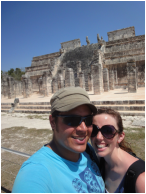
Outside one of the temples
|
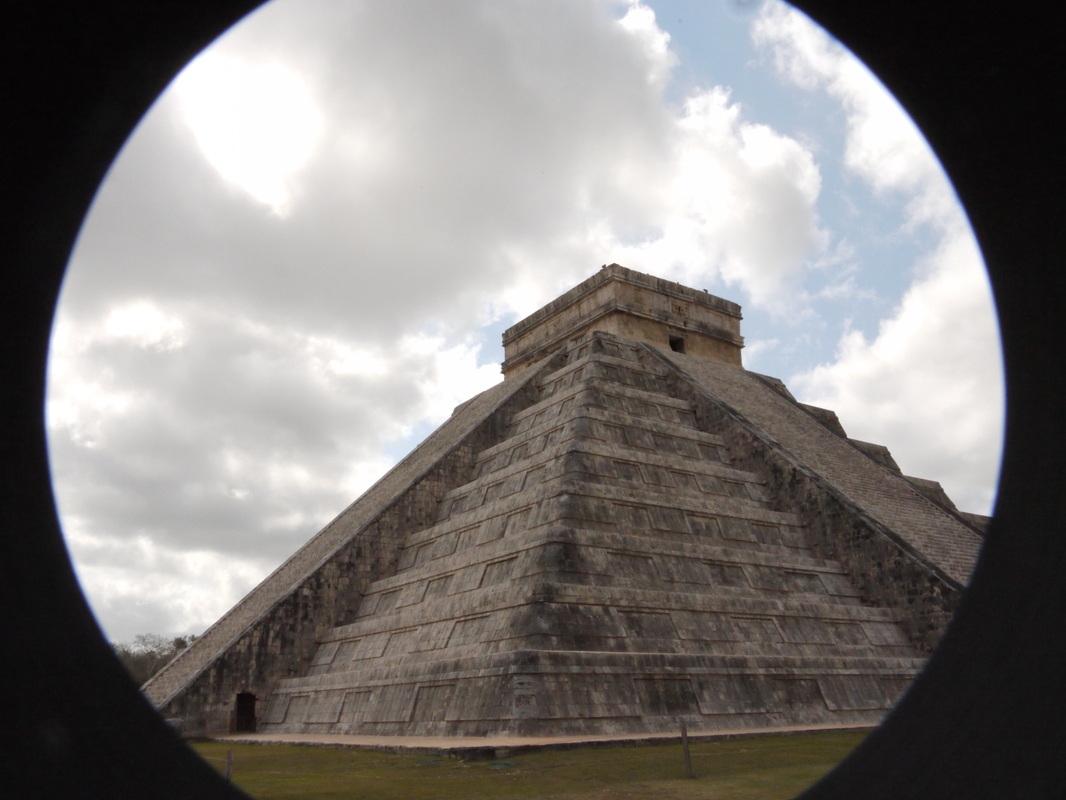
El Castillo
|
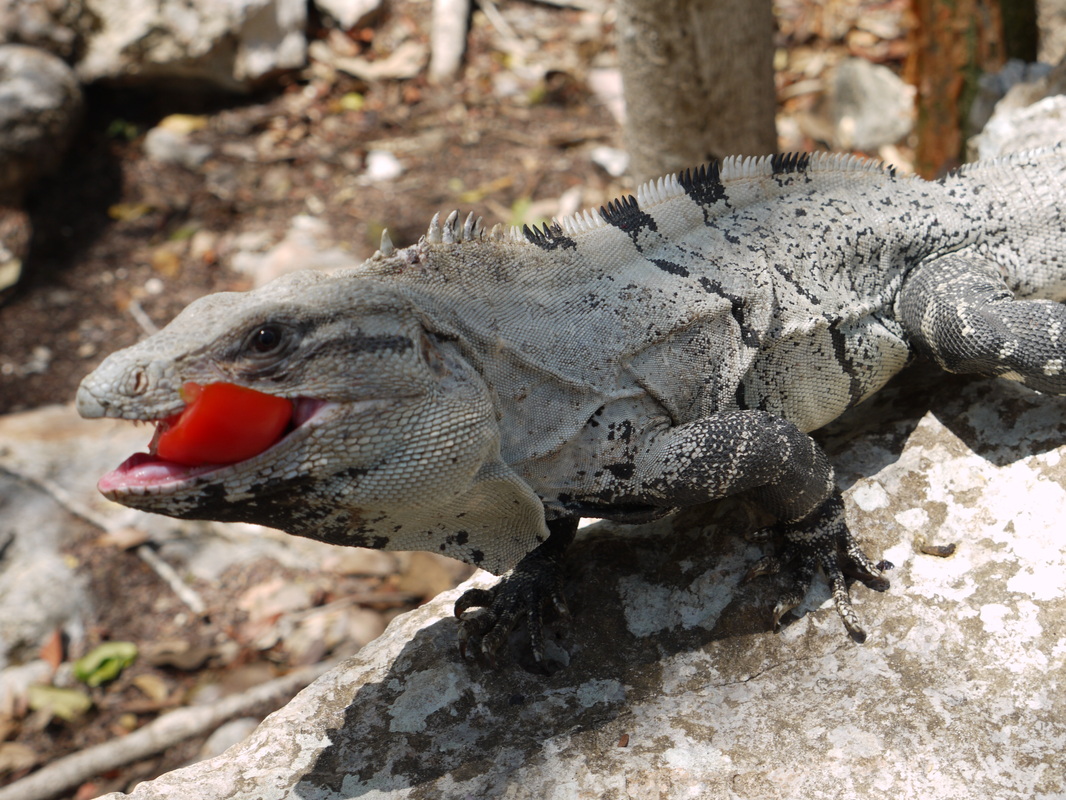
Our greedy Iguana
| There are only a couple of public buses a day to Chichen Itza from Merida, as the majority of people go on organised tours from Cancun, so we were up early to ensure that we arrived in time for the equinox at 11am. We had read that thousands of people pilgrimage from around the world to be there for the exact moment so we were a bit surprised when sitting close to the pyramid at 10.45 that there were only a few people milling around. Unfortunately google is not always accurate as we got talking to an Aussie couple who said the snake doesn't actually appear until the sun starts setting, usually around 4/4.30pm. Right when our bus to Cancun is due to leave. Bugger. Ah well! After a breakfast of pawpaw and lime under the trees we used the extra time we had gained as an opportunity to leisurely explore the sight. Chichen Itza was started around 400 AD and was described by lonely planet as jaw dropping for even the most jaded traveller, however we both agreed that the jungle setting of Palenque and the mountain top of Monte Alban were both more impressive. The fact that both of the other sites allow you to climb the structures gives you a much better understanding and appreciation of the culture, and the fact that they are less touristy means you are really able to soak up the history, without being bombarded by the touts selling trinkets and overwhelmed by the massive tour groups diligently following their leaders flag like sheep with no regard to other people on the path. Visiting the cenote at the bottom of the site we made friends with a significantly sized Iquana over lunch. We had learnt from our guide to the Cuzama Cenotes that Iguanas are vegetarians and so when one walked on by we offered him a bit of tomatoe. Initially hesitant but following the gingerbread tomatoe trail we laid out he slowly got more courageous and before we knew it the cheeky bugger was right up next to me snatching away the rest of the tomatoe. It was pretty funny aferwards watching him try to guzzle it down, much too big for his mouth but he was determined not to let it go unless we took it away from him!
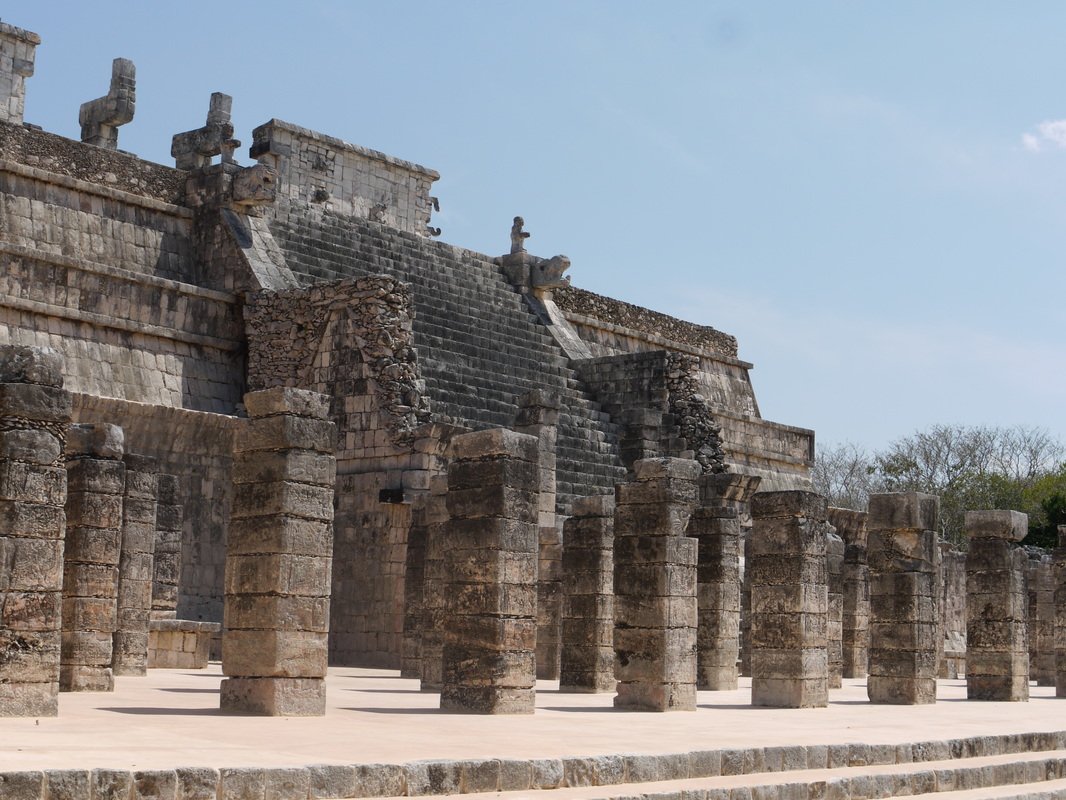
Temple of 10,000 pillars
|
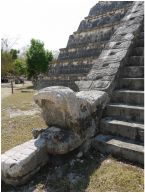
Serpent head on El Castillo
|
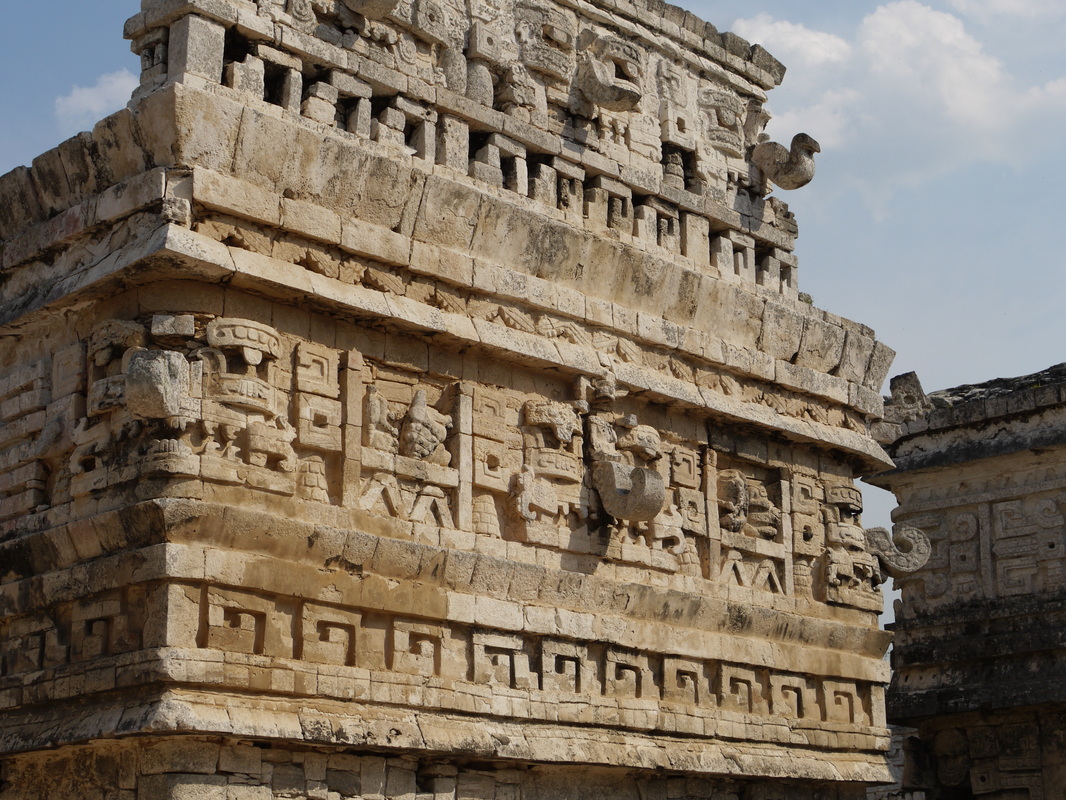
Gods of Rain with really big noses
| Walking the gauntlet of trinket vendors back up to the main part of the site we ended up having a cool conversation with one of them who, once he realised we werent the a-typical rich american tourist who visits the site (and that we weren't going to buy any of his stuff), was happy to chat with us and let us practice our spanish and him his english. It made me feel really lazy though as he was self taught and his english was a million times better than our spanish!
After a siesta under the trees we headed to the centre of the site to check out the ball court. Mayan sports included a game similar to soccer except that instead of using their feet (it is believed) they had to hit the ball with their elbows, hips, knees and stomachs through a very small hoop high up on the side wall of the court. The enormous Chichen-Itza court where this game was played is the largest ever found and is lined with fascinating carvings that display the rules and details of the sacred game. One carving even shows the captain of the losing game being beheaded!
Heading back to El Castillo we met up with the Australians we had met earlier in the day to watch the snake appear. Evesdropping on a nearby guide it was pretty cool to learn that the pyramid is also a calendar with its four sides containing 365 steps (depicting the solar year), 52 panels (for each year in the Mayan century as well as each week in the solar year) and 18 terraces (for the 18 months in the religious year). As the sun began to set and the snake began to appear on the side I have to confess a certain amount of disapointment. While it is cool that the shadows do form somewhat of a representation of a snakes body which does meet up with the stone serpent head at the bottom it takes a certain amount of imagination to see the snake 'slithering'. Half an hour later and its certainly the slowest snake I've ever seen. But to be fair, just as 21st century movie graphics have come a long way since the 80's the Mayans didnt have stephen spielberg or weta workshop so perhaps this was the peak technology of the time. Not sure I'd bother to make a special trip for it again though. Lonely Planet did get one thing right however - you only need 3 hours to see the sight.
Waiting in line for our bus to Cancun we were approached by a friendly american who wanted to know whether we were 'backpackers'. Admitting that yes we were, she go really excited and wanted to know 'how we do that'. We gave her a few tips before she took our photo making us feel a little bit like rockstars haha.
Next stop: Cuba (via Cancun)

Waiting for the snake to appear
After what should hopefully be our last overnight bus, well at least for a couple of months anyway, we arrived in Merida; the capital of the Yucatan Penninsula. Mérida was founded in 1542 by Francisco de Montejo y León ("el Mozo") and named after the town in Spain. Some historians consider it to be the oldest continually-occupied city in the Americas. The city architecture has a lot of French influence and walking along the Paseo de Manejo you are surrounded by beautiful French colonial mansions with ornate woodworking, although these days they are mostly occupied by banks or other international head offices. Coming from the DF, Oaxaca and Chiapas regions we were surprised to find that the Yucatan feels very different - much more American-ised, with TGI Friday's, Chilli's and Walmart dotted in between international hotel chains.
The hostel we stayed at offered Yoga a couple of days a week and we arrived just before the class started so I jumped in and used the opportunity to stretch out all my tight muscles from the bus trips. Ty was a bit frustrated though as the class turned out to be an hour and a half long so he was left waiting for me to go exploring but I felt so much better afterwards.
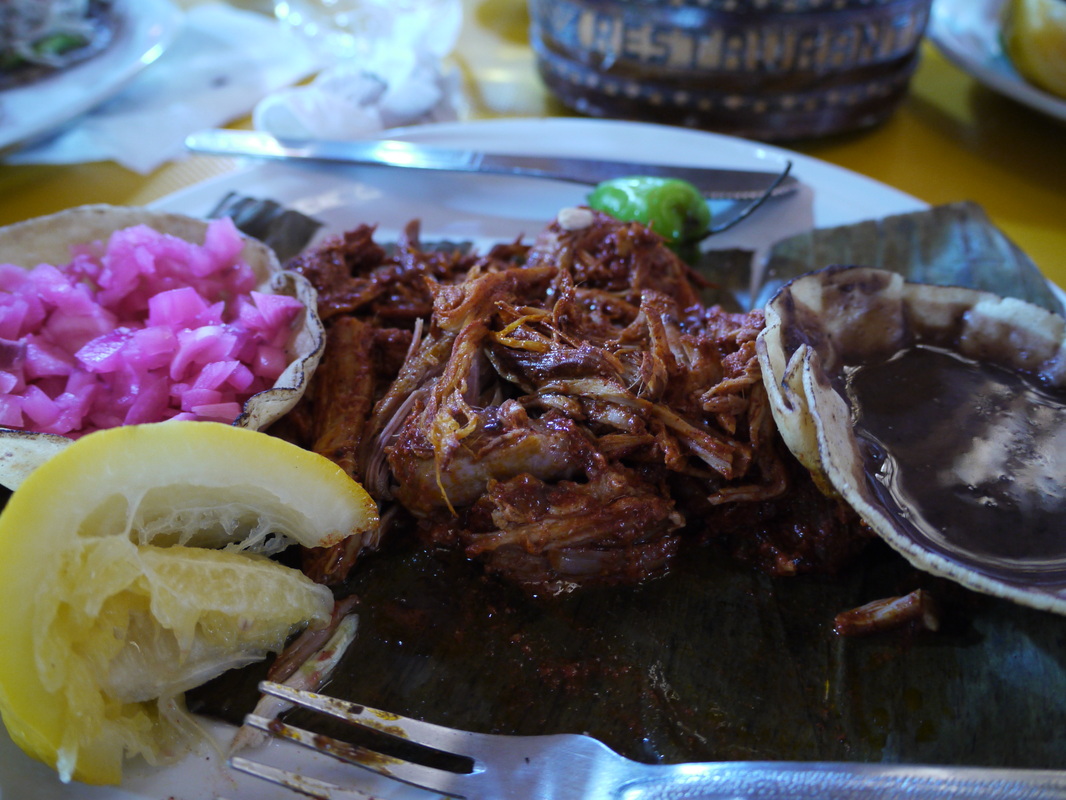
Pulled pork tacos - YUM!
|
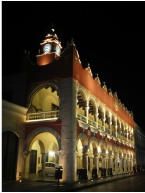
Beautiful Meridan architecture
|
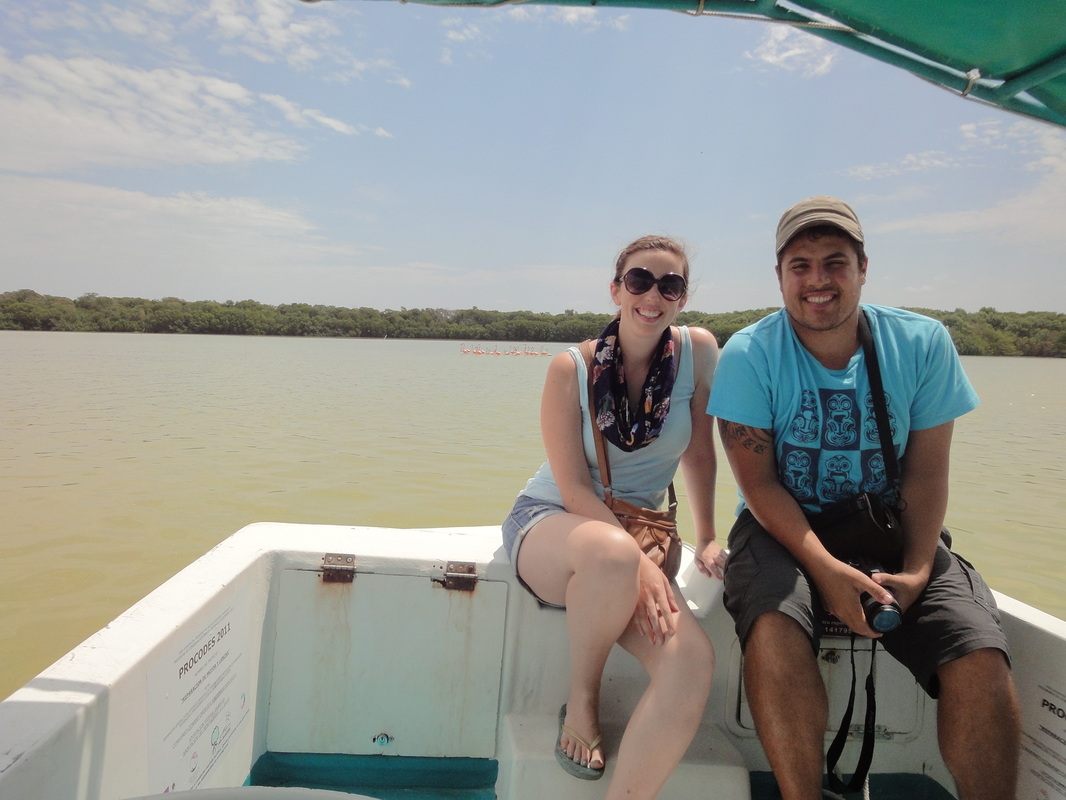
On the boat going flamingo hunting
| Seeing as it was Sunday there was a big market on in the centre of town so we walked in to have a look around and stopped for some more of those delicious pulled pork tacos I talked about before. The day was absolutely roasting and our hostel was the first one we had come across with a pool so we couldn't resist heading back to cool off and chill out for a couple of hours before we took part in the free cooking class that was happening that night to learn how to make Papadzules. We have been in Mexico for almost a month now and I was still yet to have a Margarita so we headed out to one of the bars for a quiet drink. Unfortunately the bar tender needed a few lessons so I left feeling pretty disappointed with my overpriced drink - will just have to continue the search! haha. Day 2 we booked on to a tour to Celestun, a tranquil fishing village located west of Merida. The main attraction is the Reserva de la Biosfera Ria Celestun (Celestun Biosphere Reserve), a large coastal wetland reserve and wildlife refuge which is home to thousands of flamingos. The reserve is an impressive 146,000 acres and is one of the largest areas of mangroves in the Gulf of Mexico. Freshwater from the ria (estuary) mixes with saltwater from the Gulf of Mexico creating a habitat that’s perfect flamingos and waterfowl, and the reserve is home to more than 300 species of birds including egrets, pelicans, herons. Unfortunately for us, you cant control nature and we lucked out only seeing about 50 flamingos (the day before there was 5000 of the buggers!) but we had an enjoyable boat ride and marvelled at the braveness of some local children swimming rather close to an alligator. Our captain said there were two gators living in that area of the mangrove - I'm still not convinced he was real but I certainly wasn't going to get in to find out, especially after a local made a crack about him preferring the taste of gringo!We spent the rest of the afternoon enjoying a leisurely lunch and swim at Celestun Beach before heading back to Merida. Driving back we saw big ominous looking storm clouds gathering and by the time we arrived the heavens had opened and it was pouring down. Within minutes the streets were filling up with giant puddles and I was very glad for the door to door service the tour provided! The silver lining to the first rain we've had in over a month was it gave us some time to sort out our plans for the next couple of days and book things we needed to.
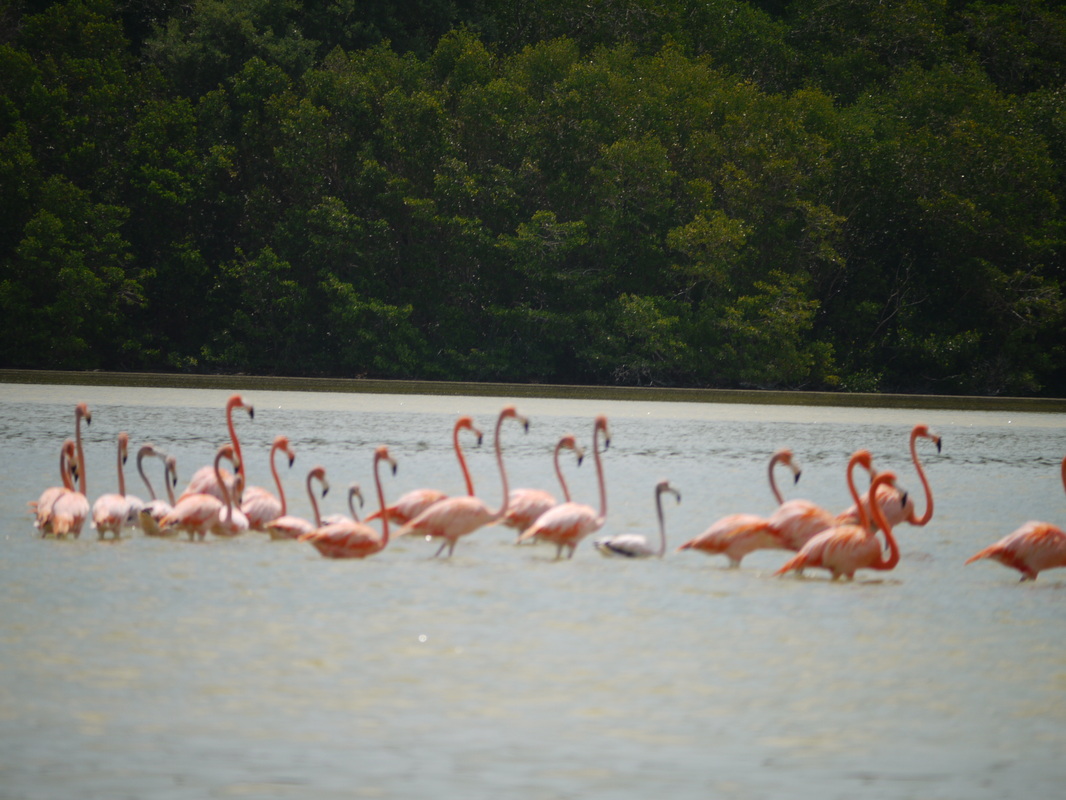
Flamingos!
|
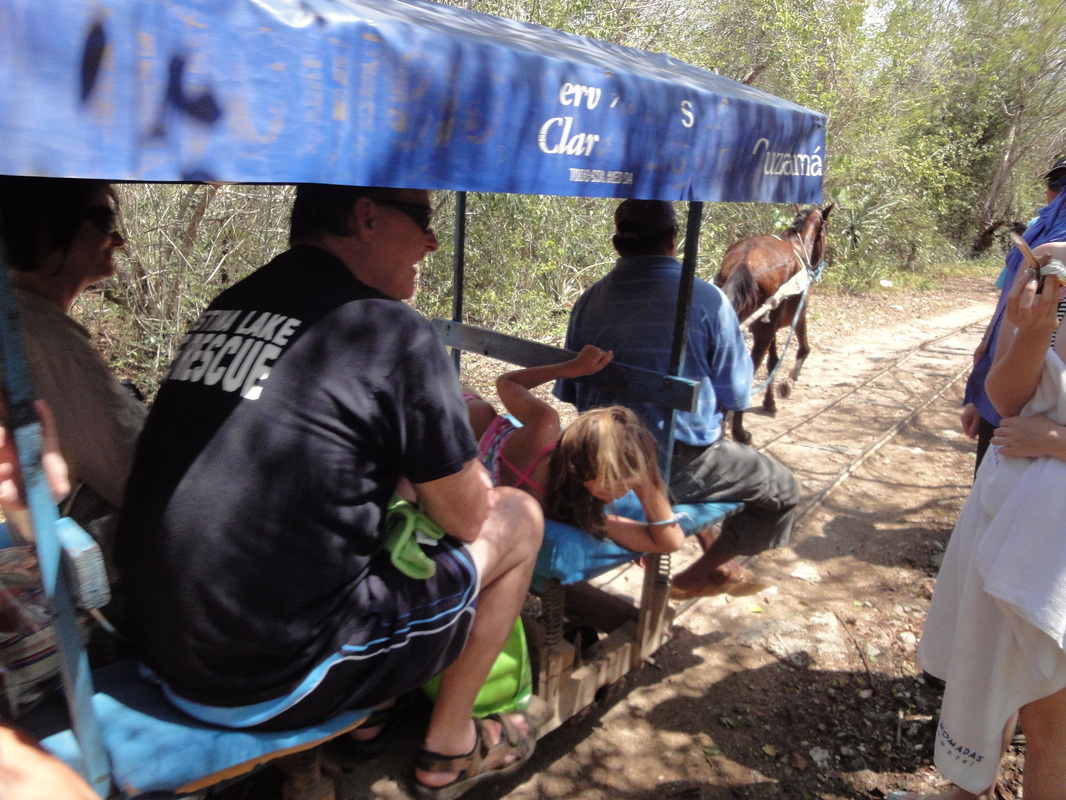
Railroad 16th century style
|
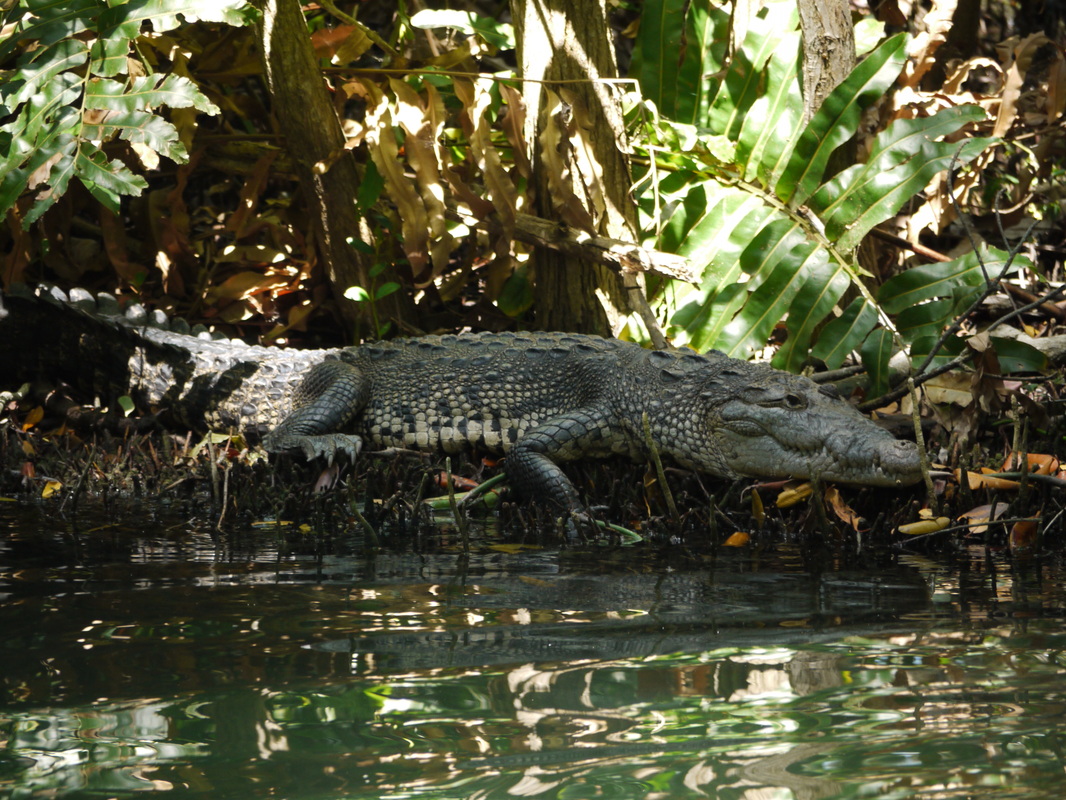
Real or not i'm still not getting in!
| The Yucatan Peninsula is full of Cenotes (sinkholes) which occur when limestone rock collapses exposing groundwater underneath creating the most amazing swimming holes if you can get down to them. Because they are dotted all over the place here we werent sure which one to go to. Some were located pretty much in town and didn't take a lot of effort to visit (one even has a restuarant built on the edge with a diving platform) and others require a guided tour. Basing our choice on the theory that the things which are hardest to get to are usually the best we booked a tour for the following day to the cenotes near Cuzama. To get to the sinkholes the locals take you on an extremely rickety horse and cart type contraption which sits on 16th century rails. I'm pretty sure we could walk faster than the horses were pulling us but it all adds to the adventure and these rides are most likely the main income supporting the locals who live there.
We visited three cenotes and had the chance to swim in all of them, although climbing down the wooden ladders held together with chicken wire didn't inspire confidence! The water was so astoundingly blue and crystal clear it was amazing! But the weirdest thing was that there were fish in there! Our guide explained that they are Catfish and because all the sinkholes are connected by underground rivers despite it looking like there are no exits they have got themselves in somewhere along the line and so now they stay. Heading back on the carts to the town we were practising our spanglish with our guide who was telling us about the region and its specialities, particularly the food. We had seen a number of Iguana's sunning themselves on the rocks during the day and Ty cheekily asked whether or not they ate them, which he said they do and did we want to try it. Up for the challenge he took us to a local restaurant and we ordered Sopa De Lima. Living up to the old 'tastes like chicken' adage I'm not convinced it was Iguana but either way it was very tasty and I'll happily order it again!
Next Stop: Spring Equinox at Chichen Itza
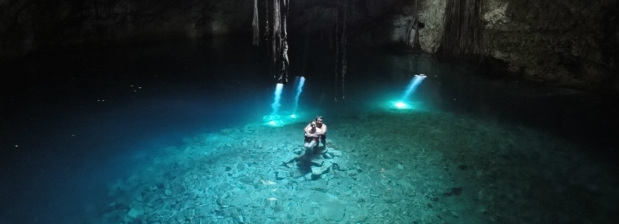
Not a bad place for a swim!
| |
Art, the lovely man at our hostel in San Cristobal told us about a tour which went to Palenque, stopping along the way at Agua Azul and the Cascades, before visiting the ruins at Palenque and then returning. The cost of the tour was about 30 pesos (£1.50) more than the cost of the one way bus. Unfortunately, the one time I have tried to be organised since we arrived in Mexico was me buying our bus ticket when we arrived in San Cristobal to 'save us time later'. We had heard about Agua Azul (beautiful bright turquiose blue waterfall) from some other travellers and were pretty keen to check it out. So despite not liking our chances we headed back down to the bus station, although we couldn't get a refund for our tickets, we were able to change the tickets for another route, so we swapped it for our bus from Palenque to Merida a couple of days later and Art booked us onto the tour :)
The day started pretty early with a 6am pickup, although it was just after 7 by the time we had everyone else from their hotels and all of our luggage was hoisted onto the roof ready to go. Because San Cristobal is in the mountains we had a pretty windy road downhill for a couple of hours, punctuated by the ever present judder bars, before we stopped for breakfast. The breakfast buffet was pretty miserable looking, and pretty expensive for what was on offer so we decided to give it a miss and tried our luck with a portion of quesadillas which turned out to be pretty pathetic ones but never mind they kept us going until later.
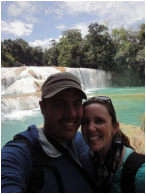
Halfway up Agua Azul
|
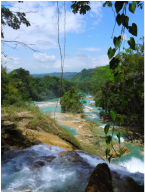
At the top of Agua Azul
|
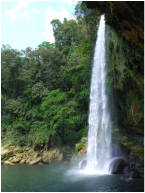
Misol-Ha
| Our first stop was at Agua Azul, a series of beautiful turquiose blue waterfalls. The day was starting to warm up and it was very tempting to hop in for a swim but since we were going to be visiting another fall later in the day we decided we would save it until then. There are lots of locals set up selling fresh fruit, juices, crafts and food along the walk to the top of the falls, and although the empanadas left a lot to be desired the watermelon went down a treat on our way back down.
Next stop was Misol-ha, a 120 foot waterfall, that you can walk behind to feel the roar of the water falling from above. The area is surrounded by Mexican rainforest which is cooling from the midday sun, but unfortunately also means the water is a little less appealing that at Agua Azul, and we immediately regretted not swimming earlier. Supposedly its wise to be off the road between San Cristobal and Misol-ha by mid afternoon (its a well known drug smuggling route) and so we headed off to the ruins of Palenque soon after.
The Palenque ruins date back to 226 BC. By 2005 the discovered area was about 2.5km² but its estimated that this is probably less than 10% of the actual city area, with thousands of structures still covered by the lush jungle which surrounds the site. Much of the history of Palenque has been reconstructed from reading the hieroglyphic inscriptions on the many monuments and Ty became particularly taken by King K'an B'alam the 2nd (Serpent Jaguar King) declaring that it would be the name of our first born son. Sorry babe - thats a deal breaker!
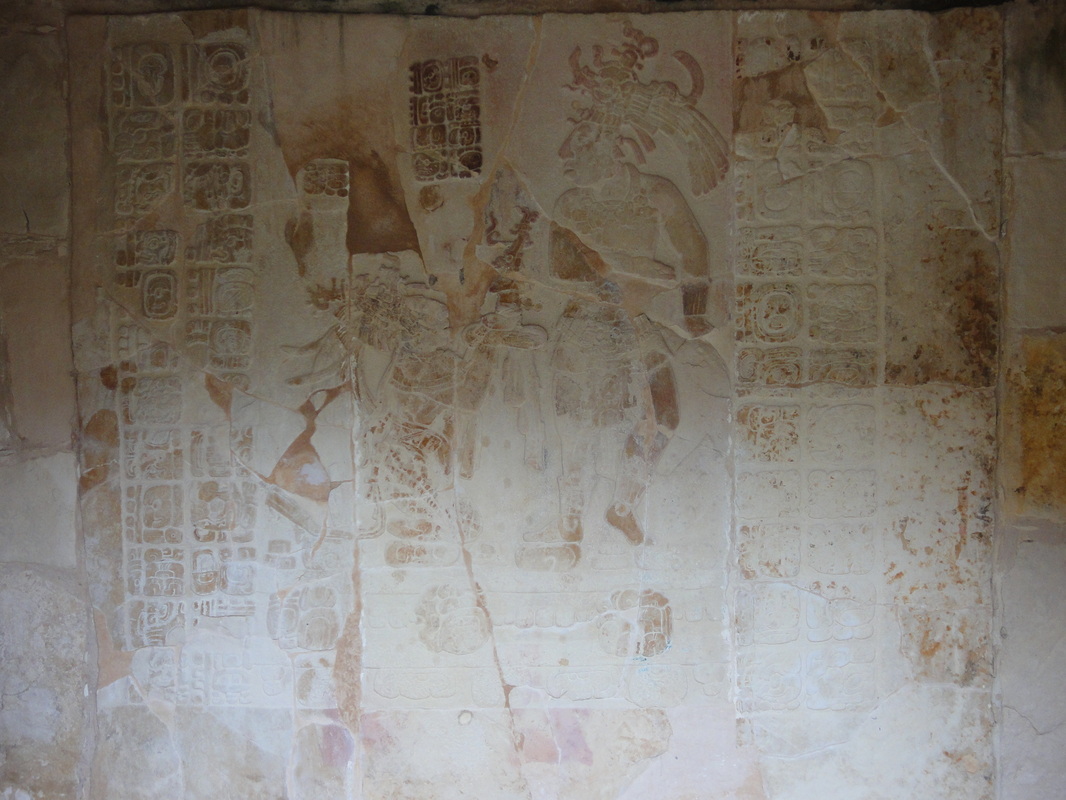
Murals at Palenque
|
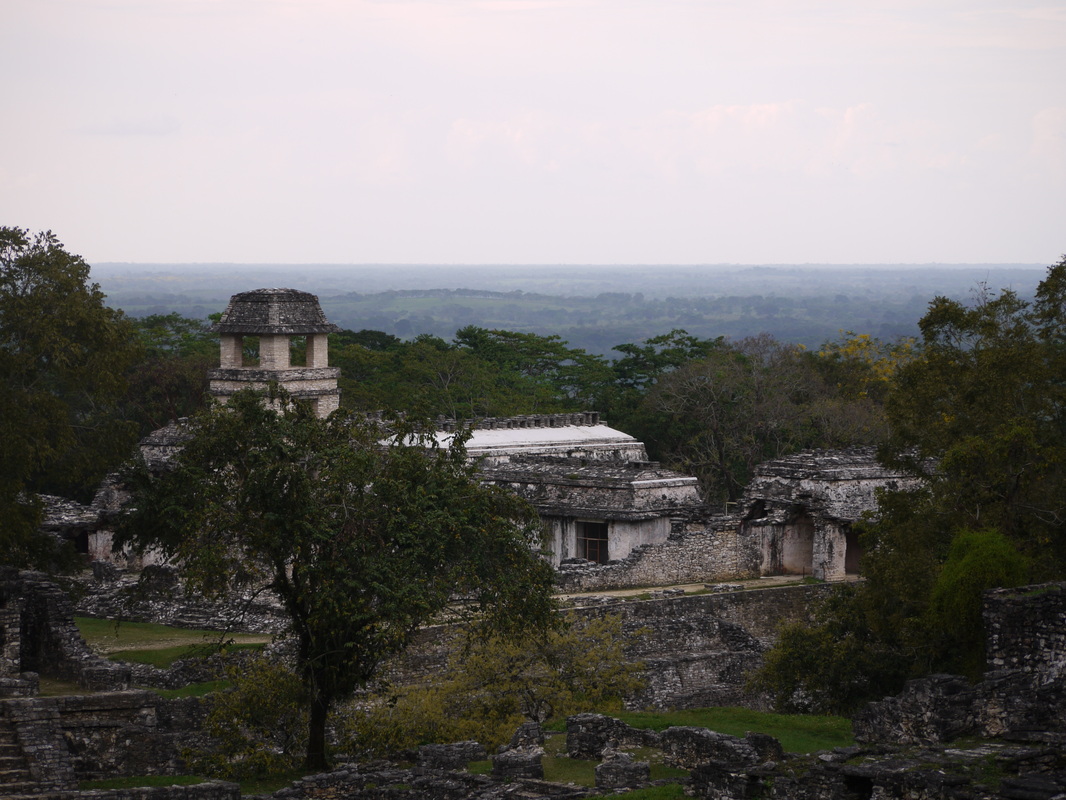
Looking towards the Grand Palace
|
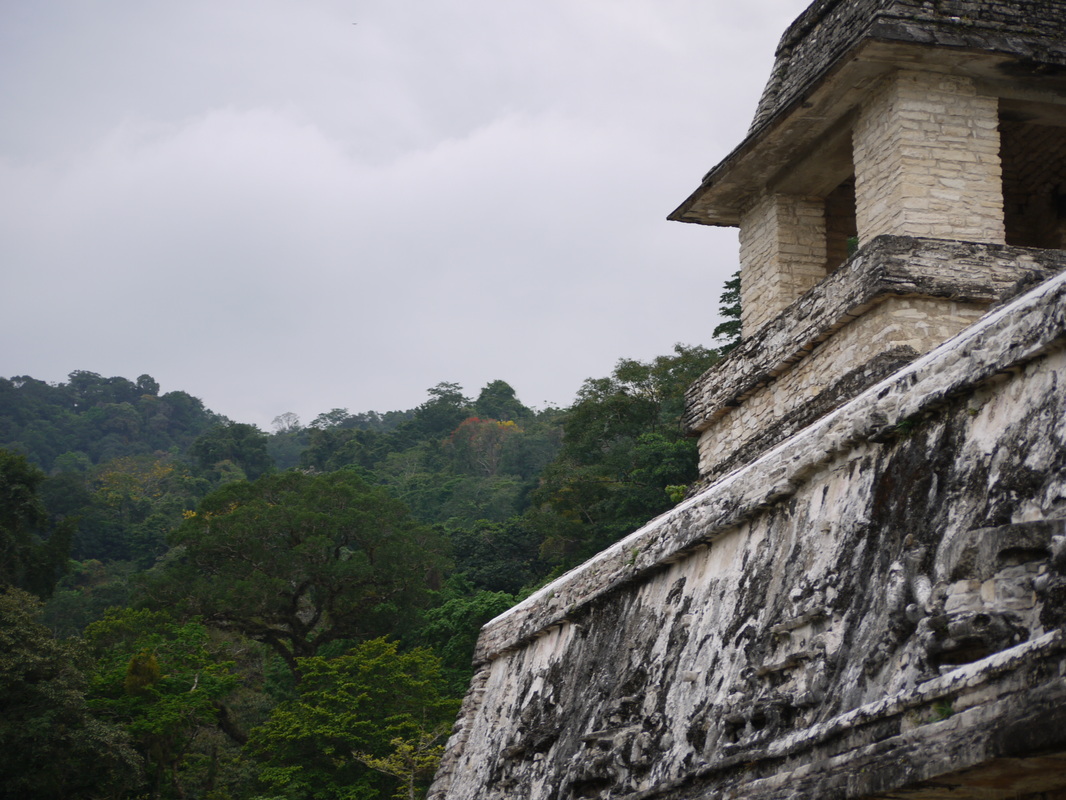
Ruins at Palenque
| Wandering around the site we were glad for the forest at the site as the afternoon had got pretty hot and we didn't have much water with us. A great thing about these ruins is that you are still allowed to climb up them which means you get different perspectives on the site from each one and allows you to appreciate the thighs of steel that the Mayans must have had walking up and down the extremely steep steps every day! I got pretty excited at one point when Ty spotted a monkey running along the branch of a tree but wasn't fast enough to get a photo of it.
Lonely Planet's opinion of Palenque town is pretty much spot on; apart from as a jumping off point for the ruins there's not really much to see and its rather uninspiring compared to the other towns we have visited so far but we ran into Nick and Nicky, a British couple we met in Oaxaca so it was nice to see them again.
Next stop: Merida
After another windy overnight bus (full of yet more of the judder bars that Mexico seems to be so fond of!) we arrived wearily in San Cristobal de Las Casas. I dont know why we keep catching them. In theory, the overnight bus is a fantastic way to save money and a great way to not waste daylight hours which could be better used exploring, but we always seem to arrive tired and then spend the next day walking around in a semi zombied state! Mexican buses are renowned for their loud music, terrrrible 80s/early 90s movies (think van damme and stallone!) and overdone airconditioning but we lucked out with a recent Reese Witherspoon rom com (good chance to practice our spanish translation skills) and a bus driver who was obviously feeling the chill of the night.
Arriving in San Cristobal we caught a local taxi to our hostel because I had a big blister on my foot and just couldnt be arsed walking. The lovely hostel owner greeted us at the door, and no sooner were we settled inside his wife was cooking us breakfast and he was telling us all about the places to go and things to see. Erika's eggs were just the sustenance we needed to get out exploring this high mountain colonial town. Everyone we had met before coming here had warned us that 'oh its so cold in San Cristobal!' and it was pretty chilly in the cool mountain air so we added a couple of extra layers before heading out. By lunchtime though it had warmed right up and we were stripping them off again. Even managed to get a bit of sunburn at some point during the day.

Bright coloured carpets
|
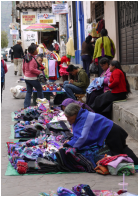
The ladies setting up the wares outside the market
|
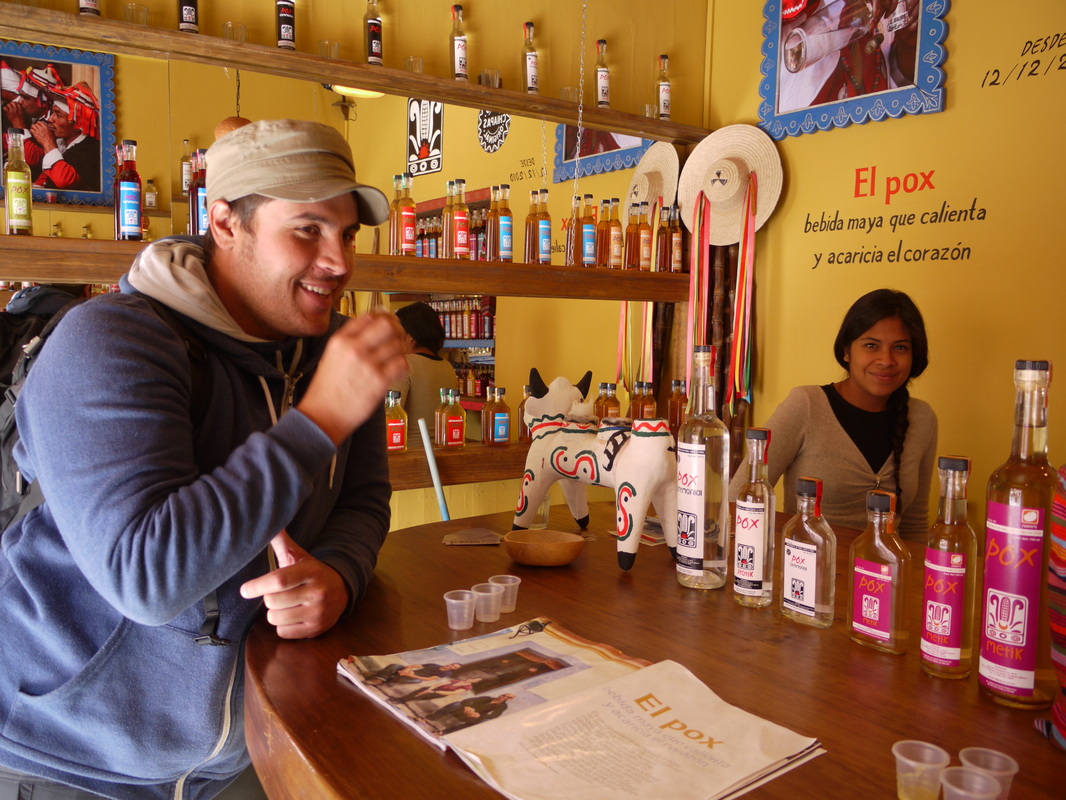
Time for a taster!
| We found the locals setting up the markets full of leather goods, bright colourful woven blankets, tapestries and other bits and bobs and despite being tempted by a few things we didn't end up buying anything. Its funny how accustomed we have become to living on the peso, some of the things we decided against purchasing we were probably arguing over £1 or £2! Wandering along one of the main streets of town we stumbled upon a 'Posheria' - interested, we wandered inside and saw bottles of spirits on the walls just waiting to be sampled. We presumed it was going to be another incarnation of the infamous mezcal but it turns out it wasnt. Pox (or 'Posh' as its pronounced) has been used by the Mayans for religious and ceremonial purposes for a long time. Despite this, until 2 years ago it was actually illegal to produce it, and the Posheria in San Cristobal is one of the first places in Mexico to get an official government licence to sell the stuff. Its made from sugarcane and comes straight in various aged varieties or infused with local fruits. The first one that the friendly owners handed us to try looked suspiciously like the white lightening mezcal so I was pretty hesitant to try it but it was actually suprisingly smooth and didnt have any of the burning sensation I was anticipating. Saying that though the aged varieties were definitly much nicer. Seeing as we were the only customers and the owners were in a good mood we spent quite a bit of time chatting with them and planning their grand empire expansion, in between sampling ALL of the flavours (be rude not to really!). We came away with just one bottle (damn our small packs!) of the blackberry infused one. Whether or not it'll make it back to NZ is still to be decided haha.
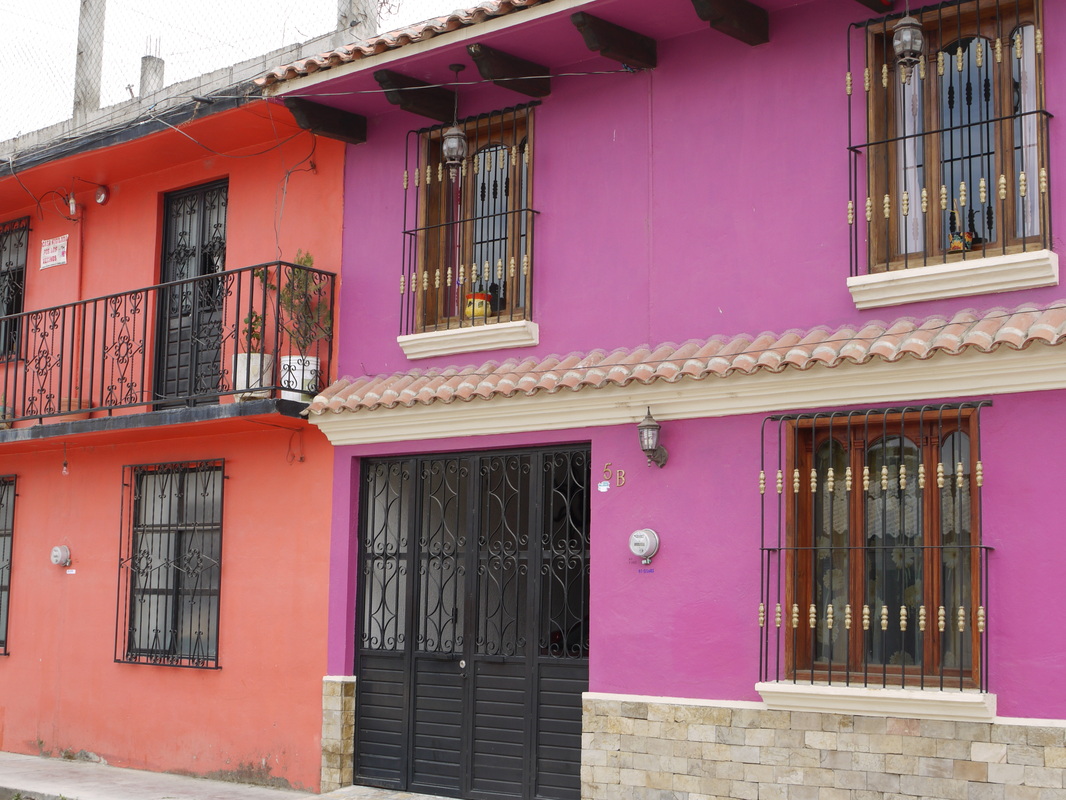
Bright colourful houses
|
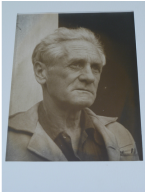
Frans Blom
|
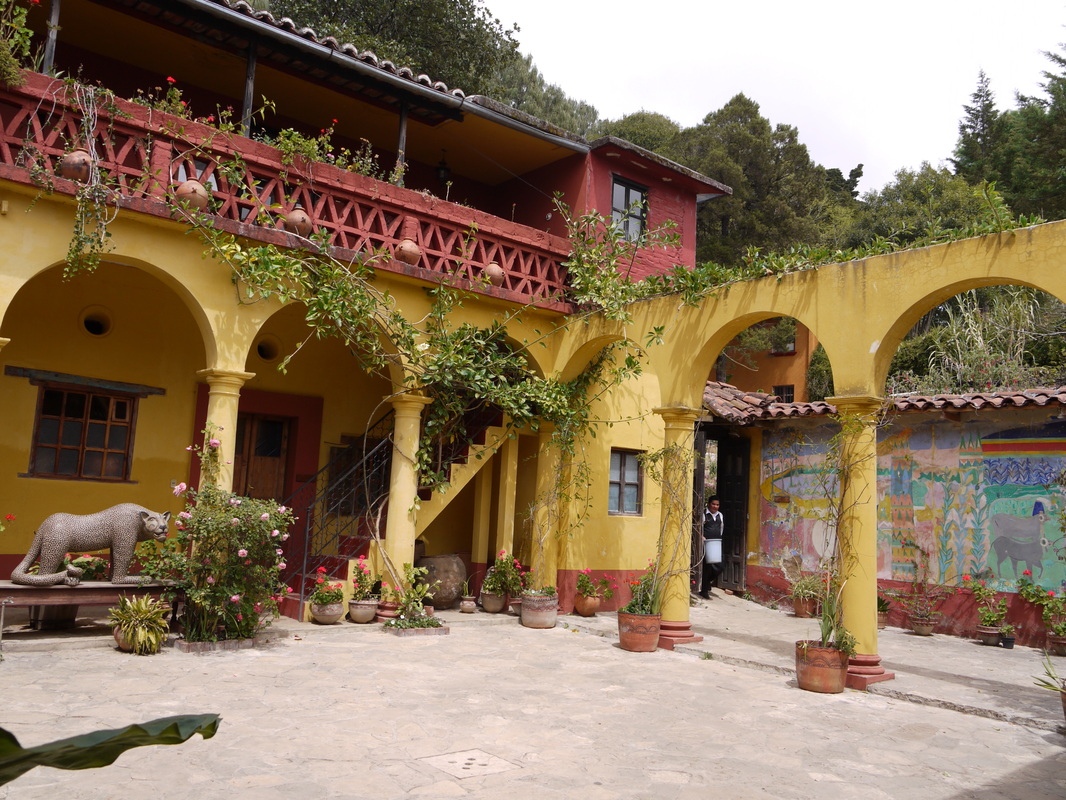
the pretty courtyard inside Na Bolom
| Wandering up the hill to one of the (many) churches we had a nice view back of the city and the chance to chill out for a bit before heading back to the hostel via another local artisan market and a museum for a siesta. The museum we visited was called Casa Na Bolom (the house of the jaguar) and it is a cultural association which was the former house of archaeologist Frans Blom and his wife, Trudi, a documentary photographer, journalist, environmental pioneer, and jungle adventurer. The Danish/German couple became fascinated with Mexican culture and devoted their lives to cultural studies and preserving the way of life of the Lacandon Maya peoples, the only Maya never conquered or converted by the Spanish. The former monastery their house is located in has been turned into an museum, and educational/study centre for the people of Chiapas and beyond. In the 1970s Trudi became very concerned about the destruction of the jungle she loved so in 1975 she expanded Casa Na Bolom's beautiful walled gardens to include a tree nursery, which 38 years on still supplies free trees for reforestation in Chiapas.
One of the funniest moments of the day had to be walking past a random corner store and hearing the London £1 fish song blaring from the radio! That night we headed back into the centro area to people watch and sample some of the slow cooked cochinita pibil (pulled pork) that the Northern Chiapas and Yucatan Regions are famous for. It was delicious! No photo for the best bites though because we were so hungry we forgot! If we can manage to resist eating it for more than 15 seconds next time ill get one I promise, although its just so damn delectable its hard to restrain yourself!Next stop: Palenque
At the end of our second week of Spanish we decided we would spend the weekend touring the local towns and seeing the sights that we had intended to do last week, but couldn't because I was sick. We booked ourselves onto a tour with a local company who supposedly ran tours in both english and spanish except unfortunately for us, we were the only people who spoke english and the guide used that as his opportunity to speak as little English as possible. While we have been learning Spanish for two weeks now, we certainly aren't at the level of comprehension for a full days tour. The first stop on our tour was in a nearby town to visit a tree. Not just any old tree though, this one is 2000 years old and is apparently the widest tree in the world. Its 58m wide, which is apparently roughly 28 people standing arm to arm around it. Pretty impressive for a tree! Next stop was a local textiles factory where they showed us how they weave rugs and other items. Again we were a bit frustrated as the guy at the factory asked whether anyone spoke English but when ourselves and another couple put up our hands we understood him enough that he said 'Oh well you can just practice your Spanish'. thanks buddy! Fortunately we visited a textile factory in Turkey a couple of years ago so we got the jist of what was going on. After that we headed to a local mezcaleria for a rundown on how the local tequila like spirit is made and enjoyed lots of free samples which made us pretty light headed since it was before lunch! One of the main highlights of the day was a visit to Mitla, the second most important archaeological site in the state of Oaxaca and the most important in the Zapotec Culture. The name Mitla is derived from the Nahuatl name Mictlan which means the 'place of the dead' or the 'underworld' because they used to bury lots of their important members of the community there. A bit like the fancy pants retirement village of the day I think haha. The original Zapotec name has the more mellow meaning of 'place of rest'. The Spanish couldnt say Mictlan so they hispanisized it to Mitla. What makes Mitla unique is the elaborate and intricate mosaic designs that cover the site. They are made with small cut and polished stones and have been put in place without the use of mortar. Researchers believe that the site was constructed as a commercial center in 850 and was still being expanded when the Spaniards arrived and destroyed it. Good one Spaniards!
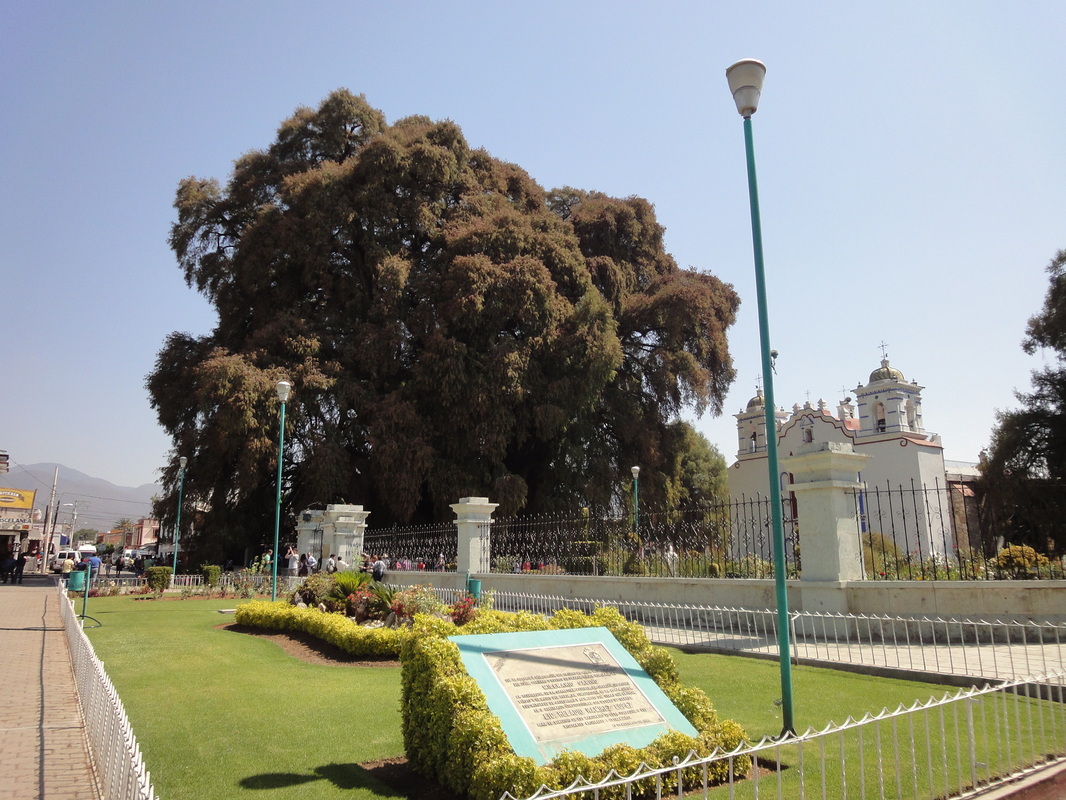
A really big, really old, tree
|
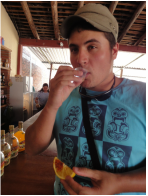
Time for a taster!
|
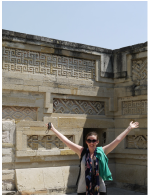
Inside the palace at Mitla
| There are tombs under some of the buildings which are decorated with mosaics and which have stairs that descend from the main plaza area. One of the tombs has an entrance that is divided by a thick column. This column is popularly known as the "Columna de la Vida" (Column of Life). According to legend, you are supposed to wrap your arms around the column, and the space remaining between the hands indicate the amount of life the you have left but unfortunately there was no fortune telling for us as they have fenced the column off.
The last stop on our tour was at Hierve el Agua, which is a set of rock formations that look like waterfalls. They have been created by fresh water springs, whose water is over-saturated with calcium carbonate and other minerals. As the water scurries over the cliffs, the excess minerals are deposited, basically the same way that stalactites are formed in caves. With their high mineral content the waters are reputed to have healing qualities and many locals and tourists alike come for a dip in the pools which have been formed at the top. The water is supposed to be thermal but its more refreshing than warm!
On Sunday we caught a local bus to the nearby town of Tlacolula. While we were waiting for the bus we managed to practice our Spanish with a friendly (and patient!) local for 15 or 20 minutes which was great. Tlacolula is a main commercial center in the area but its best known for its weekly open air market. The market is one of the oldest, largest and busiest in Oaxaca, mostly selling foodstuffs and other necessities for the many rural people which come into town on Sundays to shop and we had a good time wandering around people watching. We had hoped to buy some trinkets to bring home from the local artisans but nothing really grabbed us.

The pools at the top of hierve el agua
| | We signed up for 3 more days of Spanish this week, and while Patty has returned to the States we have Manuel as our teacher again which is good, except there's no way hes letting us get away with forgetting anything this week since he was the one who taught us last week! After class on Monday we headed to visit Monte Alban. If Mitla was the main religious centre for the Zapotecs, this was the main political centre. Monte Alban sits on top of a local mountain about 9km out of the city and offers some stunning panoramas of the surrounding valley. Fortunately for us the sky was cloudy during our visit as the site is pretty open and exposed and I can imagine it would be scorching in Summer. Given its location, the number and size of the structures is pretty amazing and we spent a good couple of hours exploring the site before we headed back into town to the local food market to feed our grumbling tummys.
On our final Tuesday night we decided we would venture to a local open air concert called Martes de Bruhas (Witches Tuesday). The concert runs every Tuesday during Lent and some of the most popular Mexican female artists perform for free each week. The guy at the hostel told us how we could catch a local 'collectivo' (kinda like a taxi but you pay per seat and squeeze in as many people as you can!) but on our way there we spotted a bus which seemed to be going in the same direction. After checking with the conductor that it went towards Martes de Bruhas we jumped on. Only problem was we thought the driver was going to tell us where to get off, but he didn't so by the time he realised we were still on the bus we were ages away from where we were supposed to be on a rather dark and lonely street! Fortunately a lovely local lady at the corner store hailed us a motor-taxi (basically a tuk-tuk) who delivered us safely to the gig. Lots of locals were hanging out in the square, relaxing under the stars and listening to Ana Diaz who had a pretty cool voice. There were also lots of tamales for sale for those who were hungry and we sampled a couple of different ones. Tamales are kind of like mashed potatoe, except its maize, with different fillings. My favourite was a the 'raja' which is chicken with tomatoes, onions and garlic. Muy Bonita!
Next stop: San Cristobal de las Casas
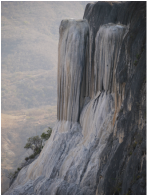
The calcified waterfalls
|
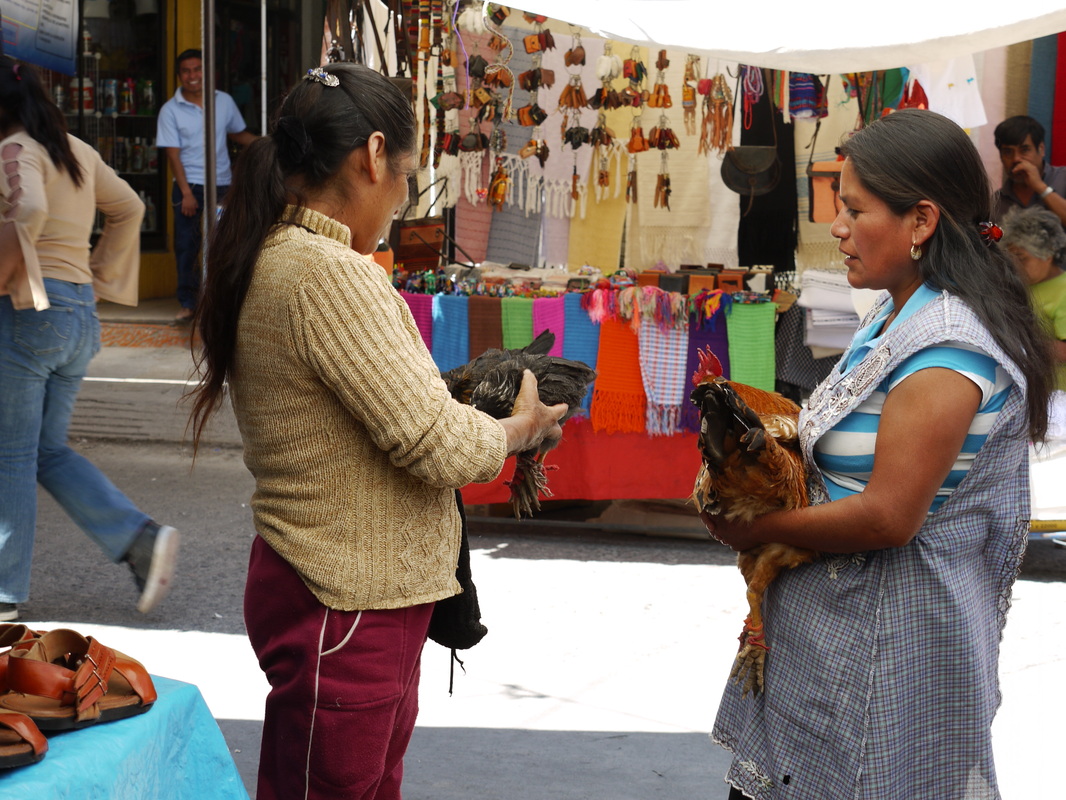
My chickens bigger than your chicken!
|
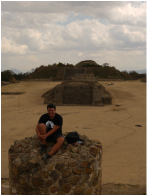
Ty at Monte Alban
|
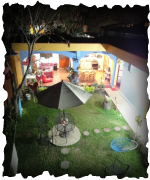 Our home for 3 weeks After some much un-needed metro delays and assistance from a wonderful local to get a taxi to the bus station we caught a 6 hour bus ride through the mountains from Mexico City to Oaxaca (you say it Waa-ha-ca) where we decided to base ourselves for a couple of weeks to learn some Spanish. Since we decided that we would just wander after Cuba it makes sense to us to be able to speak a bit more spanish than just "Una cerveza por favor!". We picked Oaxaca after hearing lots of really good things about it from other travellers. It has an old school colonial feel about it, lots of language schools and its also supposed to be the food capital of Mexico - seeing as Ty and I love mexican food it sounded like the perfect place.
Looking out the window of the bus we passed a mountain with snow capped peaks (had to remind myself it is actually winter here!), a smoking volcanoe and cactus forests which stretched for miles. Many of the farmers seemed to be practising the slash and burn method of agriculture which made us both remember our university days. I was really suprised by the quality of the roads; they rival any we have travelled on in western countries and our 2nd class bus was as good as any I've travelled on in Europe. Arriving in Oaxaca we promptly managed to get ourselves lost. It turns out that google has things upside down in Oaxaca (apparently a much known fact by the locals!) and so we walked with packs on our back for 20 minutes in the 30 degree heat in the wrong direction! Fortunately we had arrived during the day as the part of town that the 2nd class bus station is in has a whole different feel to the 'centro' which is where our hostel was. We checked into our hostel before heading to the 'Zocalo' (main square) for dinner at the local market. The Zocalo had a festive atmosphere with hundreds of locals sitting around under the trees people watching and enjoying the local band that was playing.
The hostel we booked into had a beautiful courtyard and was in a really good location but management had tiled the entire place which meant that while it looked great you could hear people roll over in the next room so we went looking for someone else to stay the next day. We found Cielo Azul hostel and decided to make it our home while we are here. It has a really nice grassed area and open plan living room/kitchen which opens out onto it and lucky for us it seems to be off season in Mexico so we usually only have to share the 8 bed dorm with 2 or 3 other people.
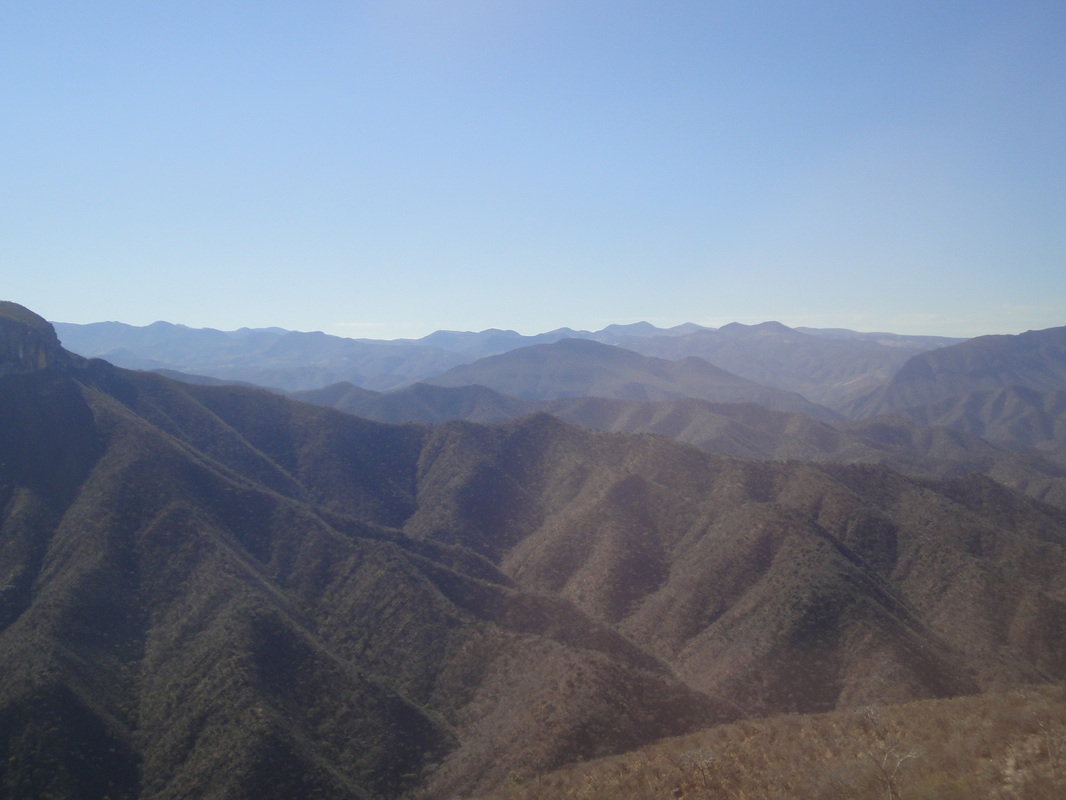
Cactus forests between Mexico City & Oaxaca
|
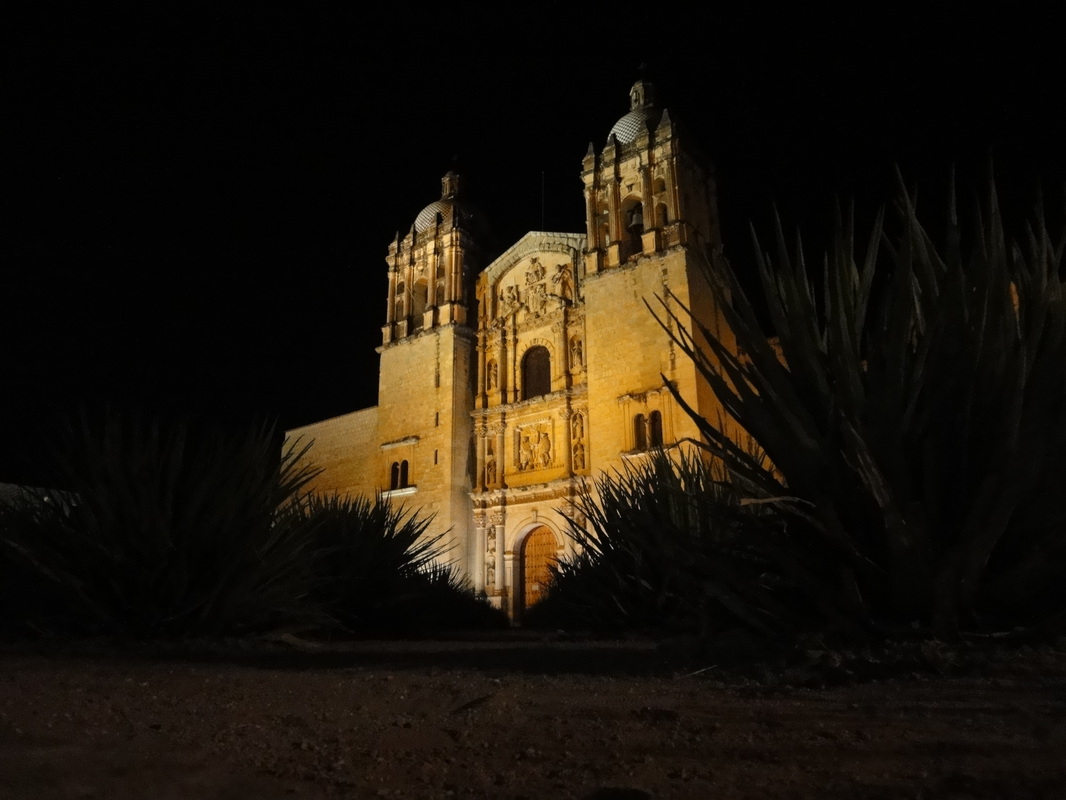
Santa Domingo Church
|
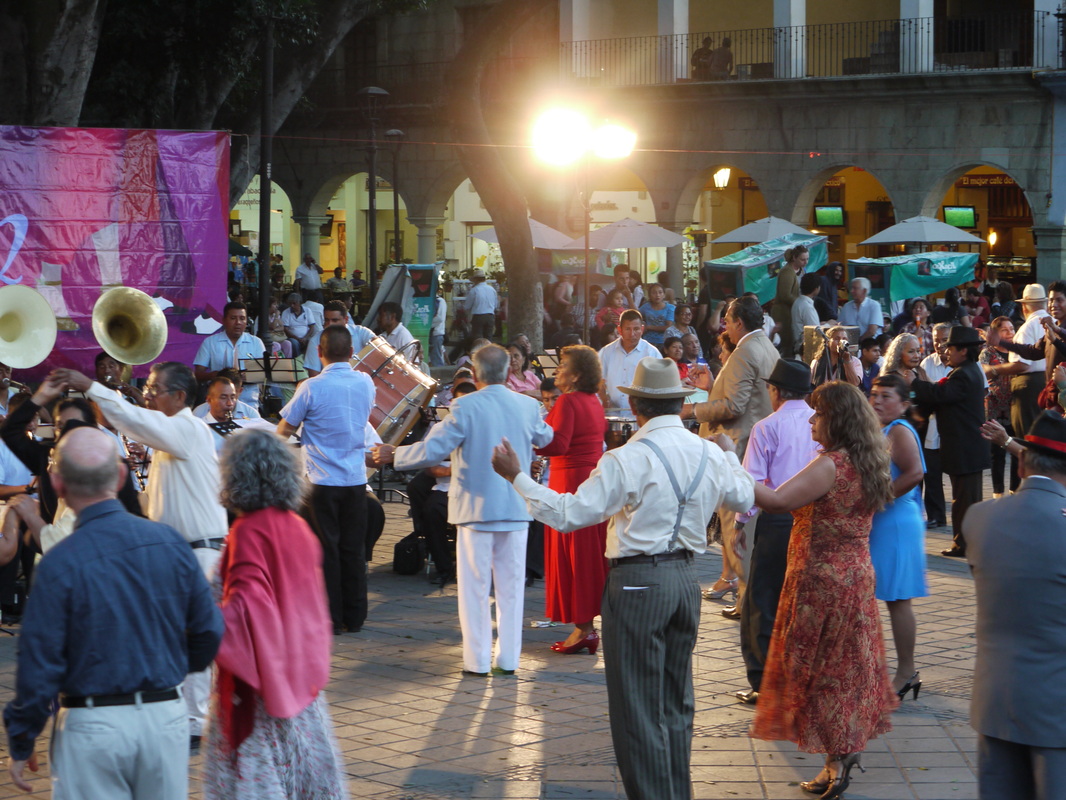
The locals enjoying dancing to the Symphony Orchestra
| After researching language schools on the internet we went on Monday morning to check out Oaxaca Spanish Magic. The school is located behind the beautiful Santa Domingo Church in the north part of the down-town so its about a 25 minute walk from the hostel. We ended getting signed up on the spot and starting our classes straight away which was a suprise but it was good to get going with things. We signed up for group classes but since we were the only beginners we got lucky and had private tuition with a lovely local lady called Carina. We committed ourselves to 20 hours the first week (4 hours of class a day plus homework) and found ourselves pretty mentally tired each night. Its been a long time since we have both worked our brains so hard! After class each day we gave ourselves a break and wandered around town soaking up the atmosphere and checking out the sites. Because we spent a bit more than we intended to in the States we took the opportunity in the first week to cut down on our spending so we cooked dinner at the hostel, or ate a big lunch with the locals at the market for 40 pesos each (£2!). We had intended to go exploring the local towns around Oaxaca the first weekend but I was struck down with a pretty bad case of Montezuma's Revenge so I didnt venture much outside our room and the couch for a few days. No idea what caused it as we both ate exactly the same things and Ty was fine. Tyro went exploring one of the other local markets with some others from the hostel but despite feeling pretty awful me being sick was kind of good in a way as it forced us to have some downtime for a few days. Much needed after 6 weeks on the road if we are honest! Week two of our Spanish course we had another lady called Patty (from America) in our group and a different teacher, called Emanuel. Manuel's a pretty good teacher but in contrast to Carina he pretty much refuses to speak English which we found really tough for the first few days. Its good to be totally immersed in Spanish for 4 hours but because we were still getting our heads around sentence structure and beginning to understand vocabulary we found it hard to keep up with what he was saying which was really frustrating. By the middle of the week I was starting to feel better so we wandered down to the Zocalo one night to watch one of the many performances which take place on a regular basis. That night it was the local symphony orchestra performing and lots of locals, dressed in their finest, had come out to dance along to the music. Some of the older men were seriously smooth looking dudes with coordinated suits, suspenders and fedora hats. On the Thursday Ty and I celebrated our 11th anniversary with a seriously good dinner at Los Danzantes. As it was Patty's last week at the school, Manuel offered to take us out to one of his favourite local restaurants on the Friday night and we had a really nice evening together. The place he took us to was up on one of the hills behind the town so we had an amazing view out over the city. Probably not somewhere we would have found by ourselves as Lonely Planet had scared me about wandering up there at night. To be continued... | |
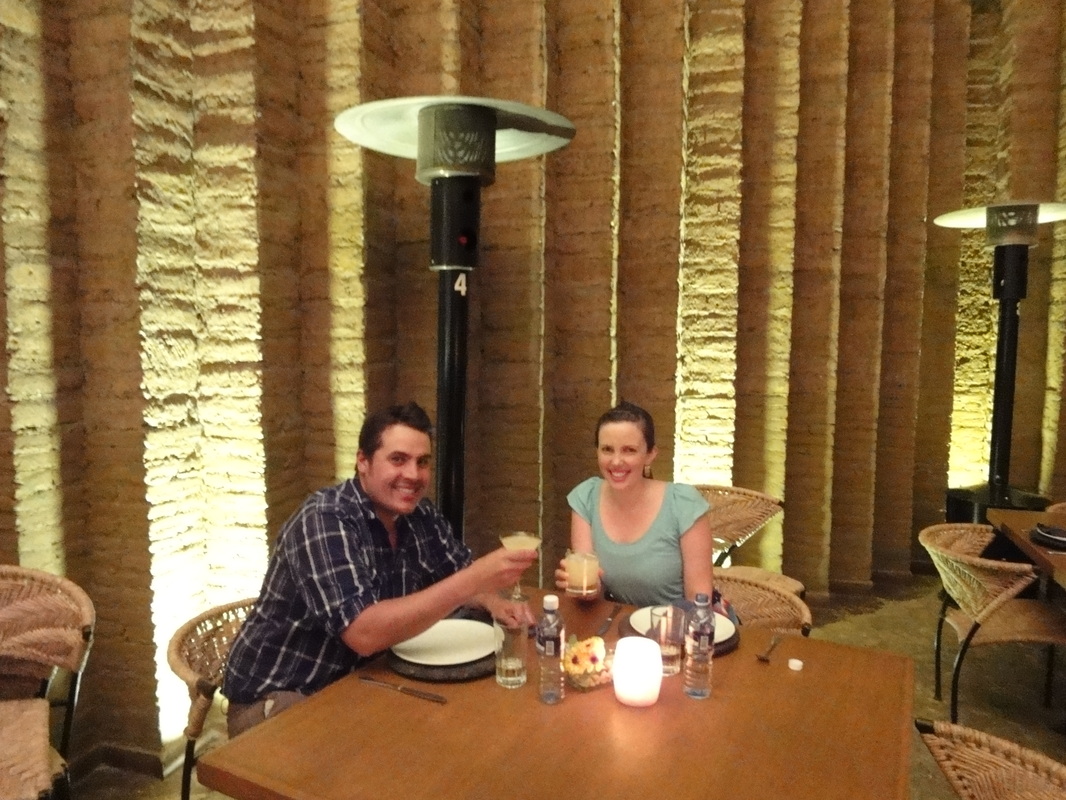
Celebrating 11 years together
|
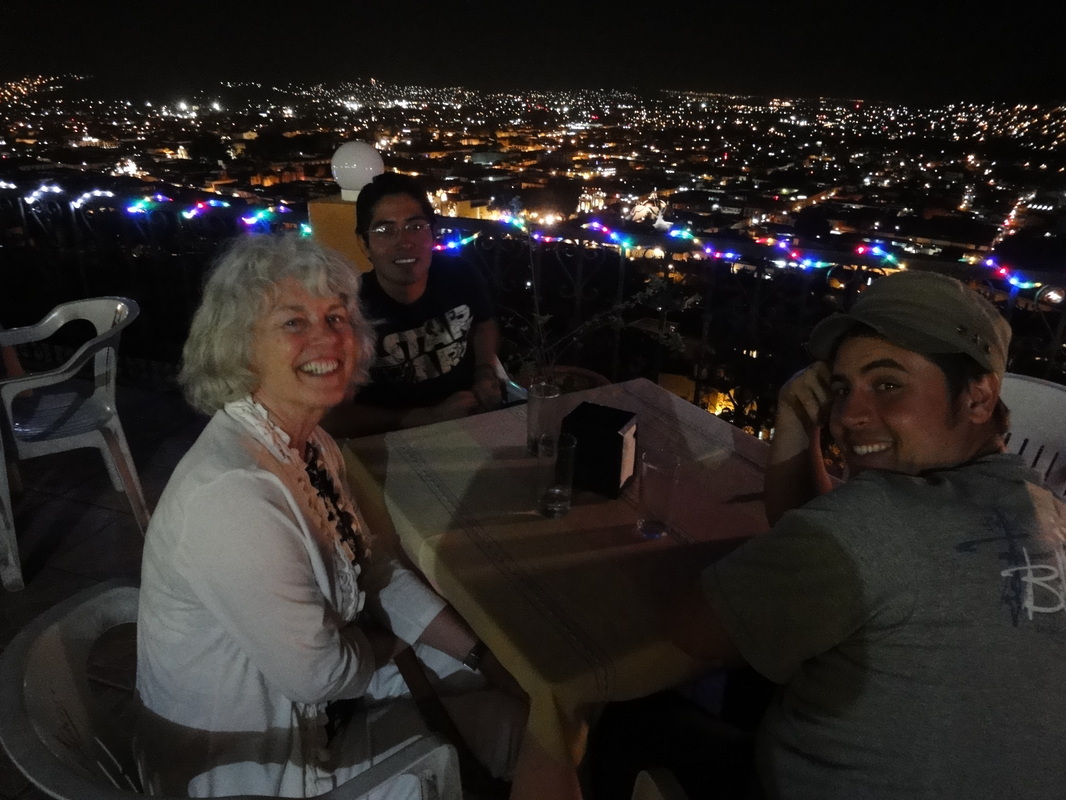
Dinner with an amazing view
|
Tequila is made from blue agave and by law must be made in the state of Jalisco (and a few other limited regions) so the rest of the Mexico had to come up with another name for their spirit. Oaxaca is famous for its Mezcal, tequila's strong, smokey, badass older brother, which for the most part is made today exactly the same was it was made 200 years ago. It is distilled from the Maguey plant (a type of Agave plant). There are over 200 different species of Maguey used to make the spirit and over six million litres of the stuff is produced in Mexico annually.
We visited a local Mezcaleria last weekend who gave us the run down on how its made. It takes 7 years for the Maguey plant to mature to the stage where it is ready to turn into Mezcal. The factory cuts off the leaves and the roots and uses the 'pina' (the heart) of the plant. To extract the juice the heart is cooked in a pit in the ground for up to 4 days, covered with earth and hay, kinda like an 'Umu' back home. After its cooked the skins are removed and the insides shredded. The shredded Agave is then mushed into a pulp by a donkey pulling a stone wheel (although the donkey we watched seemed like he might have taken a few too many tasters of the mashed substance, as his tongue was lolling drunkenly out of the side of his mouth!). Rumour has it that the old recipes for Mezcal required two chickens or turkey breasts to be placed in the mash during fermentation to add flavour, but I'm pretty sure that practice doesn't happen at the main factories today. After it has been left to ferment, the pulp is placed into a distiller and the final product is placed into American Oak barrels to start the ageing process.
The young Mezcal, basically straight from the distiller, is called aguadiente (firewater) for a reason! As you place the shot glass to your lips the white lightening immediately starts to burn. Its that drink that you can smell from across the room, its aroma more like petrol, or moonshine, than the delicacy the locals speak of. However, the aged varieties are a different story. The 'Anejo' (aged for 8 years) goes down like a smooth whiskey, warming you on the inside. The typical way to drink Mezcal is to sip it, or shot it, followed by an orange slice dipped in worm salt (salt, chilli and the ground up worm from the bottom of the bottle). The fabricas (factories) also make creamy varieties these days - similar to kahlua and baileys - which are way too easy to drink! With flavours like chocolate, passionfruit, hazelnut, mango or pistachio and an alcohol content of up to 55% we were happily on our way by the time we had finished with our free samples!
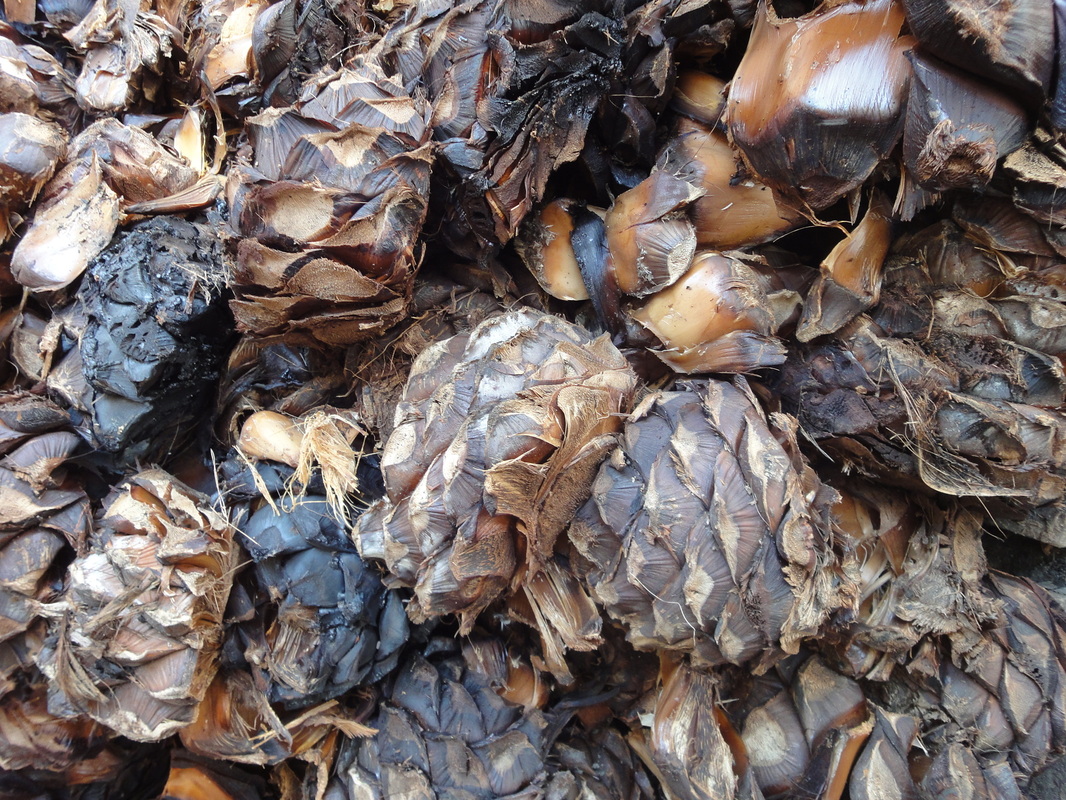
The cooked agave
|
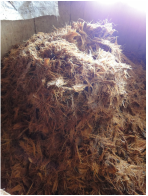
The shredded agave
|
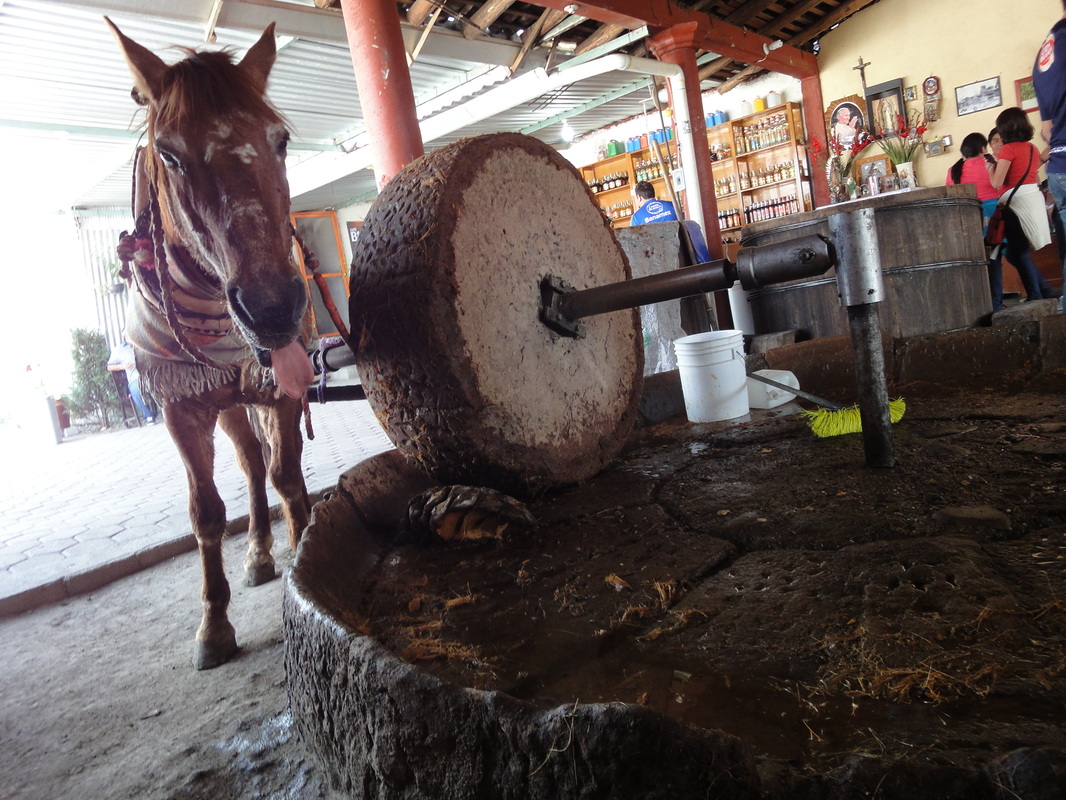
Drunken donkey ready to roll!
|
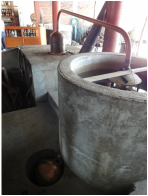
The distilling process
|
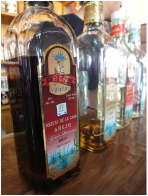
The good stuff!
|
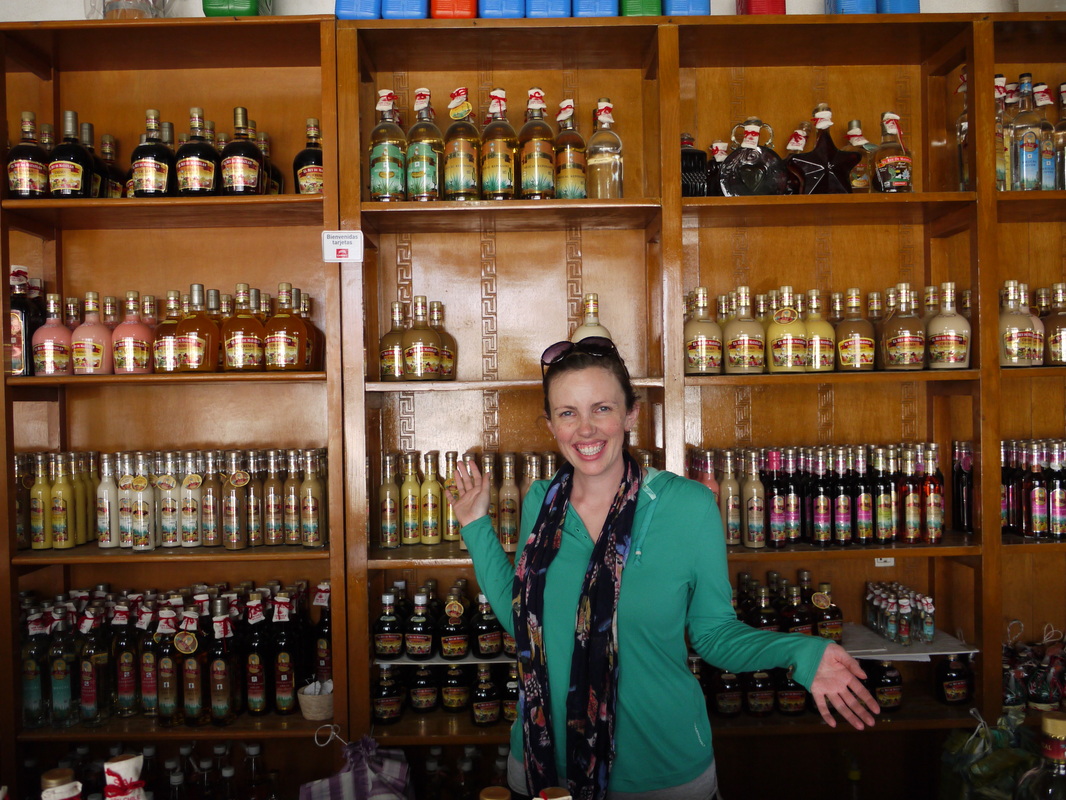
So many choices! (plus a pretty cheesy grin after 10 or 12 free samples!)
|
What do you get when you combine 26 oiled; (mostly) muscular, men and 3 midgets all dressed in lycra, and hundreds of Mexican locals with 8 gringos out for a good time? The craziness that is Lucha Libre!
On Friday night, a group of us from the hostel decided to flag the expensive tour they were offering and head to Arena Mexico by ourselves. Apparently the largest arena specifically built for professional wrestling in the world, Arena Mexico hosts the filmed for TV "CMLL Super Viernes" (Super Friday) and for the bargain price of 75 pesos (£3) we got to spend 3 hours watching grown men and midgets parading around in lycra.
The unlit streets around the stadium filled with vendors selling cheap tacos and an abundance of wrestling masks give the place a festive yet grimy atmosphere. Buying tickets through the bulletproof windows of the ticket booth where you can only see the fingers of the person serving you just adds to the occasion. Unable to resist we all fork out for a mask and head into the stadium although a thorough frisking from security gets most of our cameras confiscated. Putting on our masks we were immediately transformed into super awesome luchadores - that is until we looked around and realised the only people in who weren't in the ring wearing the masks were us gringos! ah well - let the show begin!
Flanked by bikini clad models who couldn't keep a beat if they tried and who were real Monet's (those of you who have watched 'Clueless' will know what I mean!) the luchadores all paraded out on to the stage to the beat of random macho nineties rock songs. Hundreds (but not thousands) of excited Mexicans began waving their beers and swearing at their favourite villains
An eager bartender tried his luck overcharging us for our beers only for his attempts to be thwarted by our spanish speaking amiga. Boom! That's right buddy - we're onto you!
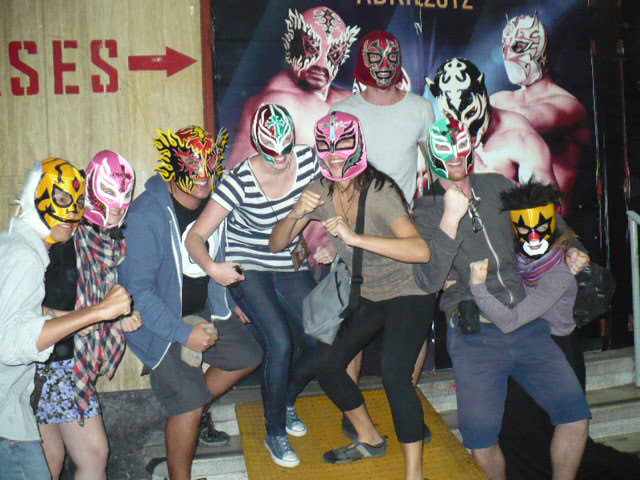 tough luchadores! | | 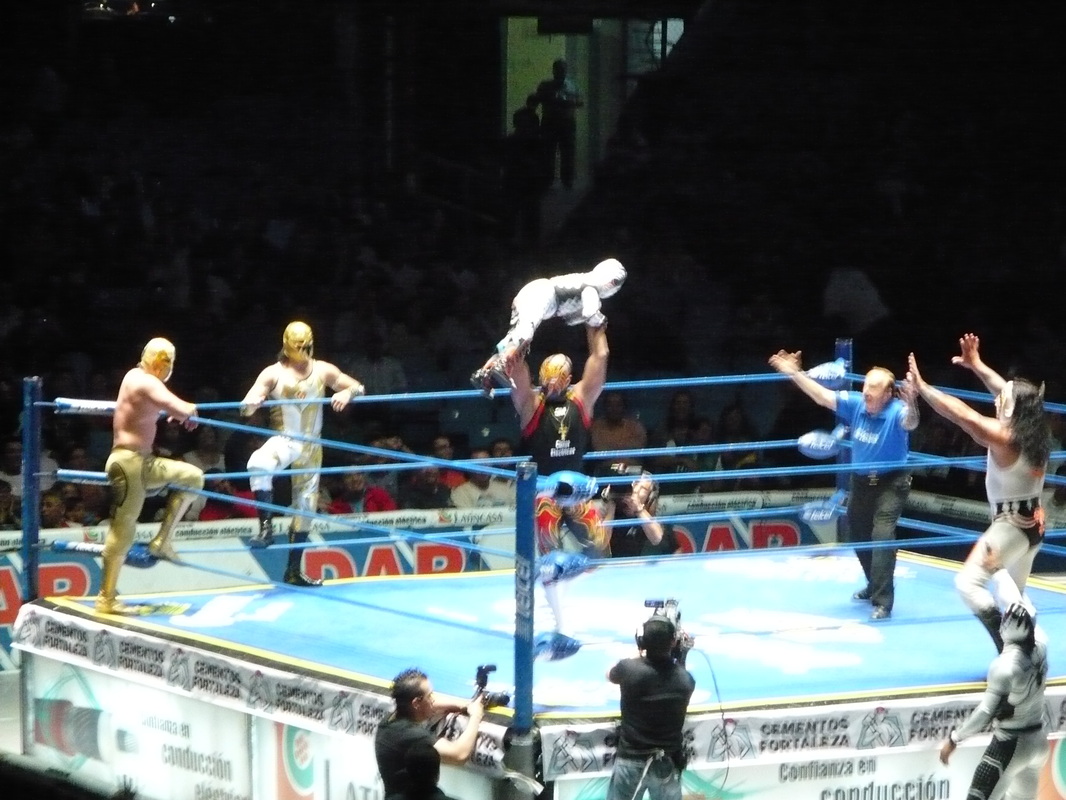 Watch out front row that midget's heading your way! | Deciphering what's going on, beyond the obvious tousling, is a little tricky but basically the 'rudos' are the big, burly baddies who usually cheat their way to beating the 'technicos', the lets say, less brawny, but more tactical fighters. Even though we didnt understand it was easy enough to join in with the cheering, booing and chanting which is an integral part of any match.
The enormous wrestlers began flinging each other around the ring in a carefully arranged set of choreographed moves. While there were some very impressive aerial acrobatics we quickly grew weary of the repetitiveness, that is until 2 wrestlers strode onto the stage with their mini-me's and began tossing them at each other, and into the front row of the audience. Reminiscent of the temper tantrum mini-me throw in Austin Powers the respective midgets took to each other with their pounding little fists and the crowd went wild.
With the importance placed on masks in lucha libre, losing your mask to an opponent is seen as the ultimate insult, and apparently results in disqualification of the oppenant who removes it, but there must be more to it than that as when one wrestler de-masked another he seemed to win that round leaving us all confused!
The second to last match involved two beefcakes in spandex who looked well past it, but they definitely saved the best for last as when Rush stepped out on the stage all the females in the crowd went wild. Perfectly toned arms and shoulders, and a pert tukus, well, lets just saw we joined in the appreciation of such a fine specimen.
By the time the final '3 count' was done, our glasses were empty and we were all more than ready to head out. The short metro ride and walk back to the hostel was filled with bemused locals enjoying the spectacle of masked gringos debriefing the evening that was.
Flying into Mexico City was daunting. The city is HUGE! And with an estimated population of 30 million people I was a bit nervous about what was in store for us.
I was pleasantly surprised. The city is very clean and despite the publicised crime rates we felt really safe walking around! One of the perks of having 30 million people is that you have access to a large labour force. I had expected the city to be dirty and grimy but there is an army of street sweepers and we even spotted people mopping the floor of the subway platforms (London could learn a thing or two!). Even when we drove out into the suburbs the streets were free from litter.
The hostel we booked into was supposed to give us a free airport pick up, but when we called them after customs as we had been told to do, surprise surprise, their taxi was currently unavailable. This wouldn't have been a problem except that we didn't have any mexican peso's on us and the atm machine wouldn't accept our eftpos cards. Fortunately we had a few american dollars left which once converted was just enough for a taxi into town. The hostel did end up refunding most (but not all) of the cost of the taxi for us but it was a bit of a hassle we could have done without.
Hanging out at the hostel bar that night we made friends with another Kiwi (Kylie), an Aussie (Jonno) and a Pom (Laura) who were heaps of fun. The next day we flagged the expensive hostel tour and went with Kylie and Jonno on the local buses to Teotihuacan, an enormous archaeological site 48km out of the city. The site contains some of the largest pyramid structures from the pre-Colombian Americas and is pretty impressive to visit.
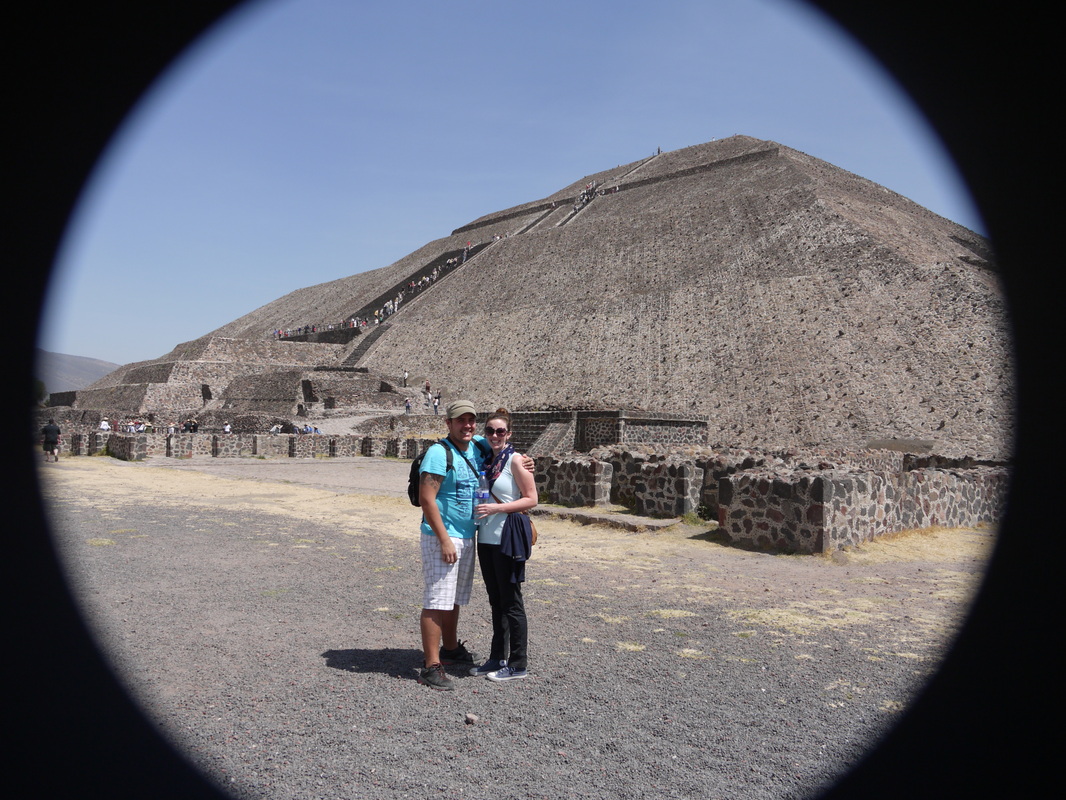
At the base of the Pyramid of the Sun
|
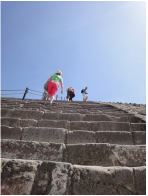
Climbing the extremely steep stairs
|
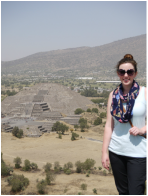
Made it to the top! Looking down on the Pyramid of the Moon.
| Teotihuacan means "where man met the gods" and it began as a new religious center in the Mexican Highland around the first century AD. Excavations have led archaeologists to believe that there was a diverse group of peoples who came from all over Central America to live at the site and at its peak Teotihuacan had over 180,000 inhabitants. Just like when we visited the ancient cities in Turkey, it always amazes me that a city of that size would just cease to exist. That's the same size as Darwin in Australia. A local guide told us that no one is completely certain what caused the population to leave the site, a number of theories abound, but they think it happened over a 100 year period.
The site covers 83 square kilometers but a mere 2 square kilometers have been uncovered to date. Walking down the "Avenue of the Dead" we reached the "Pyramid of the Sun" (believed to be the largest pyramid of the complex). Archaeologists believe that it used to be called the Pyramid of the Rain God, but that it was changed at some point by one of the inhabiting cultures. Hungover Jonno decided it was time for a siesta under a cactus while the rest of us climbed the extremely steep stairs to the top in the midday sun! The view was amazing, and there was a nice breeze to cool us off. We saw pictures at the museum from what must be the peak of the summer tourist season and I am really glad we aren't here then as you could hardly move for people and they do not allow you to stop and enjoy the view from the top.
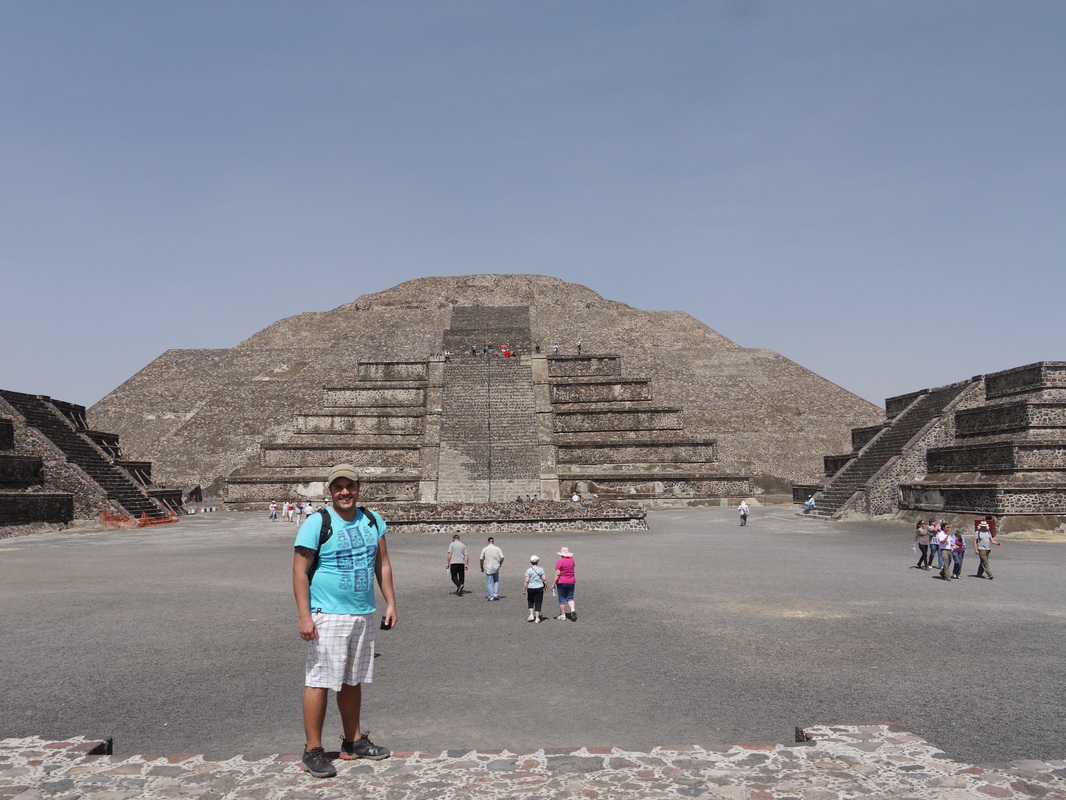
Ty in front of the Pyramid of the Moon
|
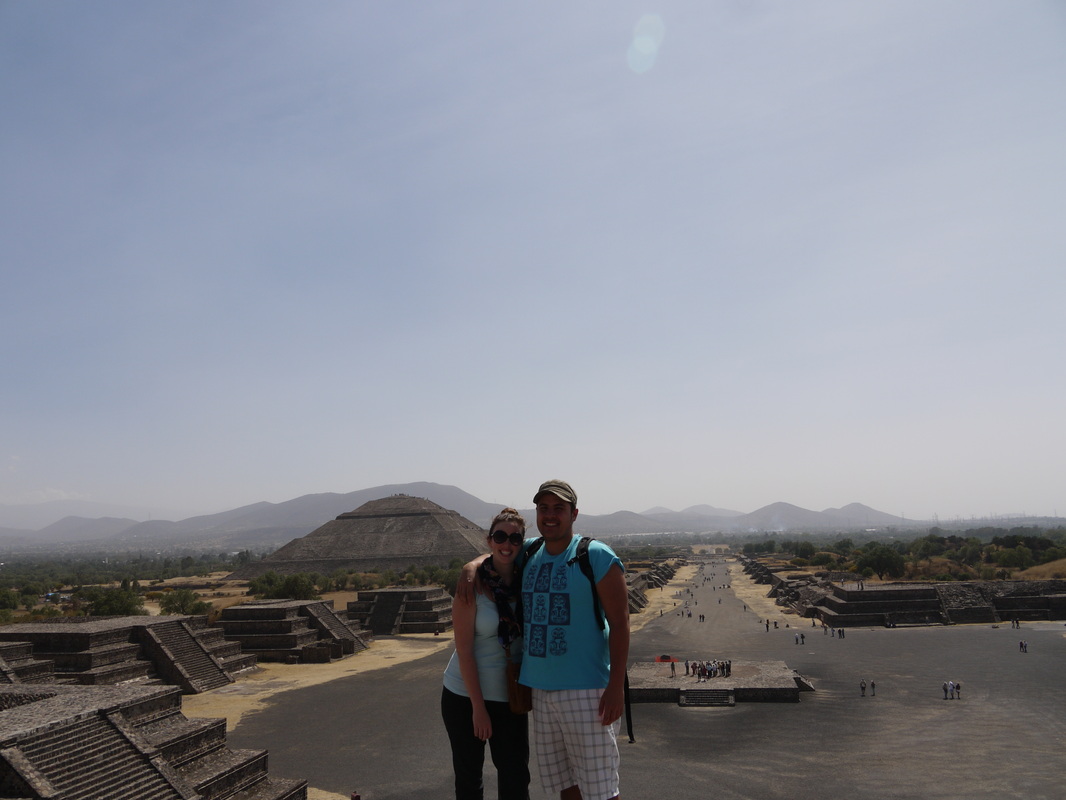
Looking back down the Avenue of the Dead
|
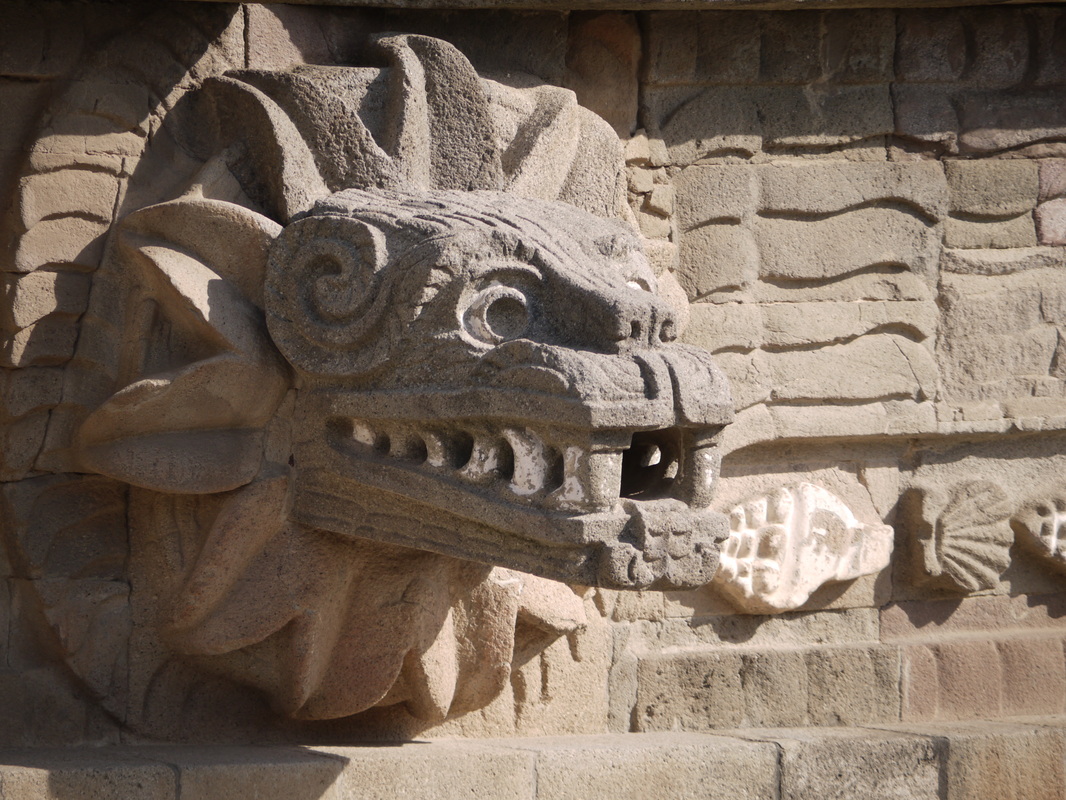
One of the serpent heads
| After this we headed to the end of the Avenue to the Pyramid of the Moon. This pyramid has smaller ones beside it and if you stand at the base of the stairs and clap your hands you get an echo that sounds like an animal noise. Crazy, but very cool! We ran into a local that Kylie knew who told us about a pyramid at the other end of the avenue which has statues of serpents so after a quick taco lunch we went to see it. It is believed that the pyramids all used to be covered in a concrete like substance made from the ash of local trees and water and then painted bright colours. Although most of the decoration has been lost to the elements you can see glimpses of what would have been in one section of the site. It would have been a truly beautiful city in its prime!
Arriving back at the hostel we found that someone had broken into Jonno's locker and stolen his tablet and his cash and another guys cash and cell phone. Fortunately we were lucky and nothing of ours had been taken but it was a bad end to a really good day out!
After organising our bus tickets, we spent the next day exploring the local artisan and food markets and eating lots of freshly made green tacos con queso, cilantro y picante (cheese, coriander and hot sauce) from a lovely old lady on the street corner. While the hygiene might have been questionable theres no doubt the exhaust fumes must have added something to the flavours, but none of us got sick so its all good. They were so tasty!
Next stop: Mexican Wrestling!
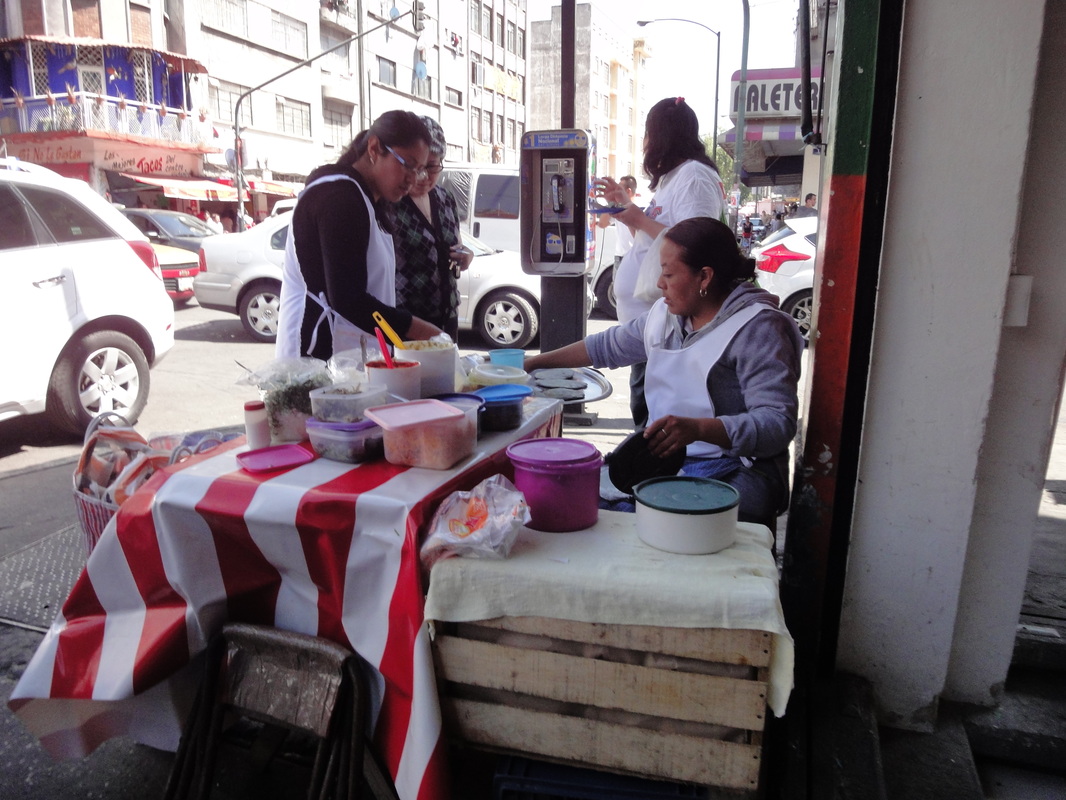
Street food
|
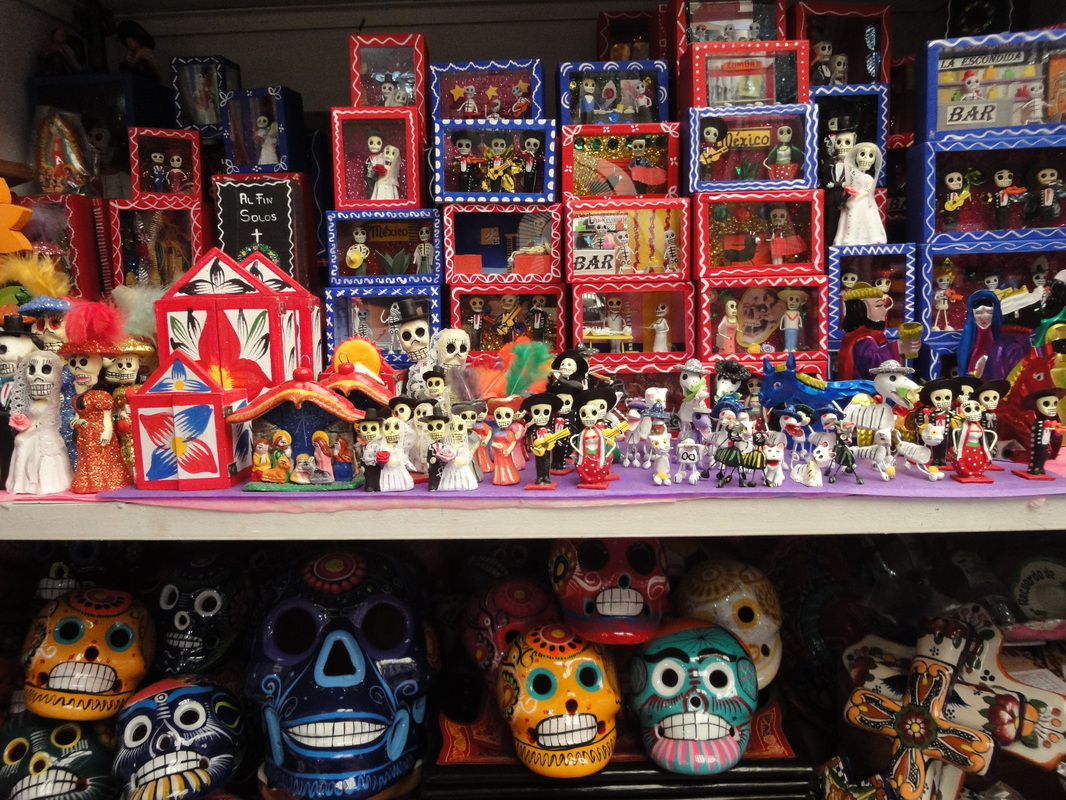
Day of the Dead pieces at the artisan market
|
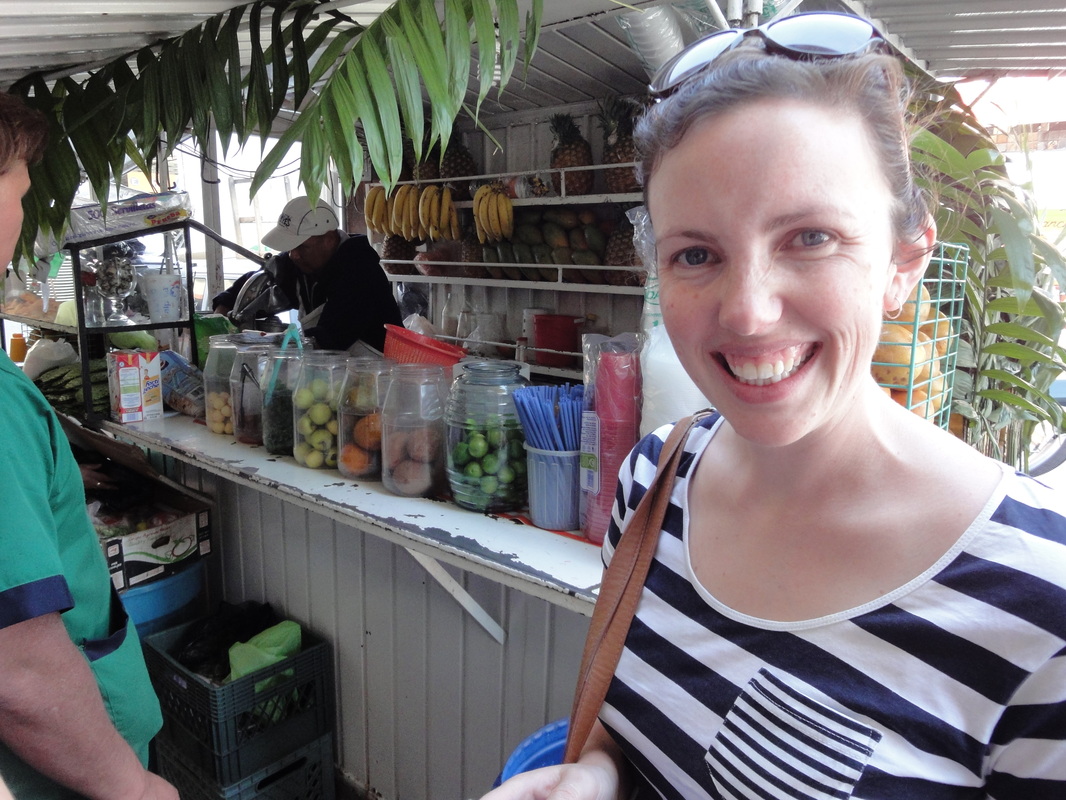
Fresh juice for 15 pesos! (75 cents)
|
|






































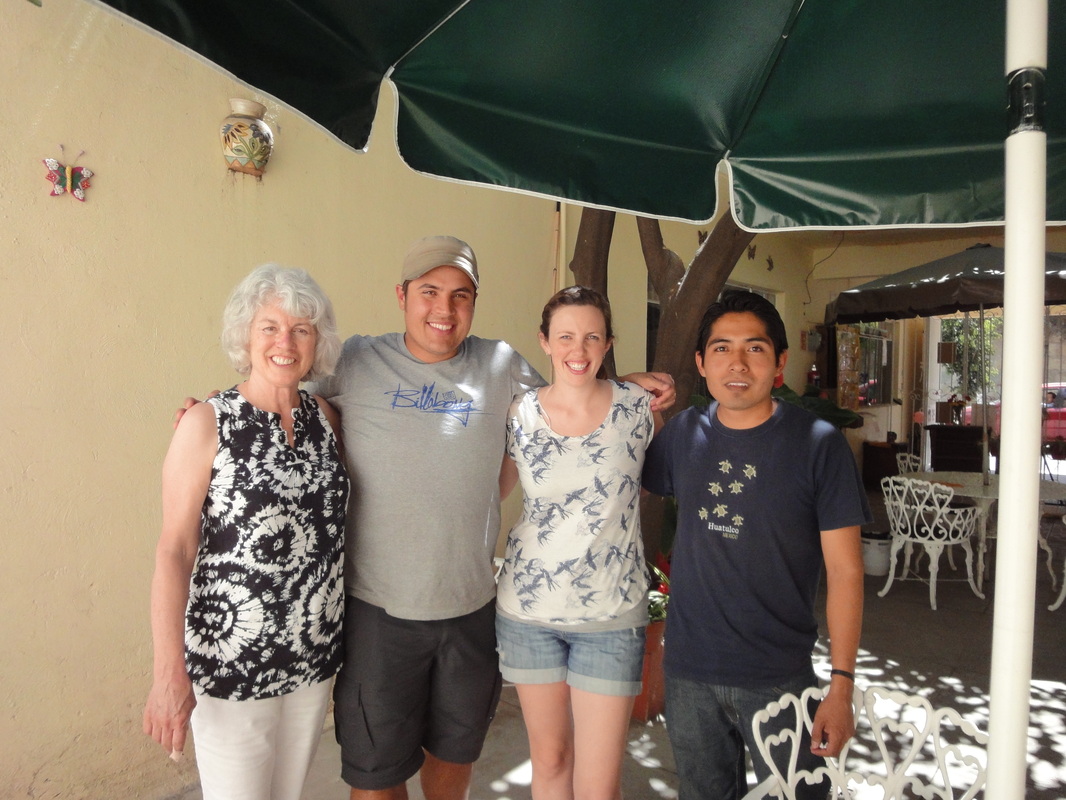









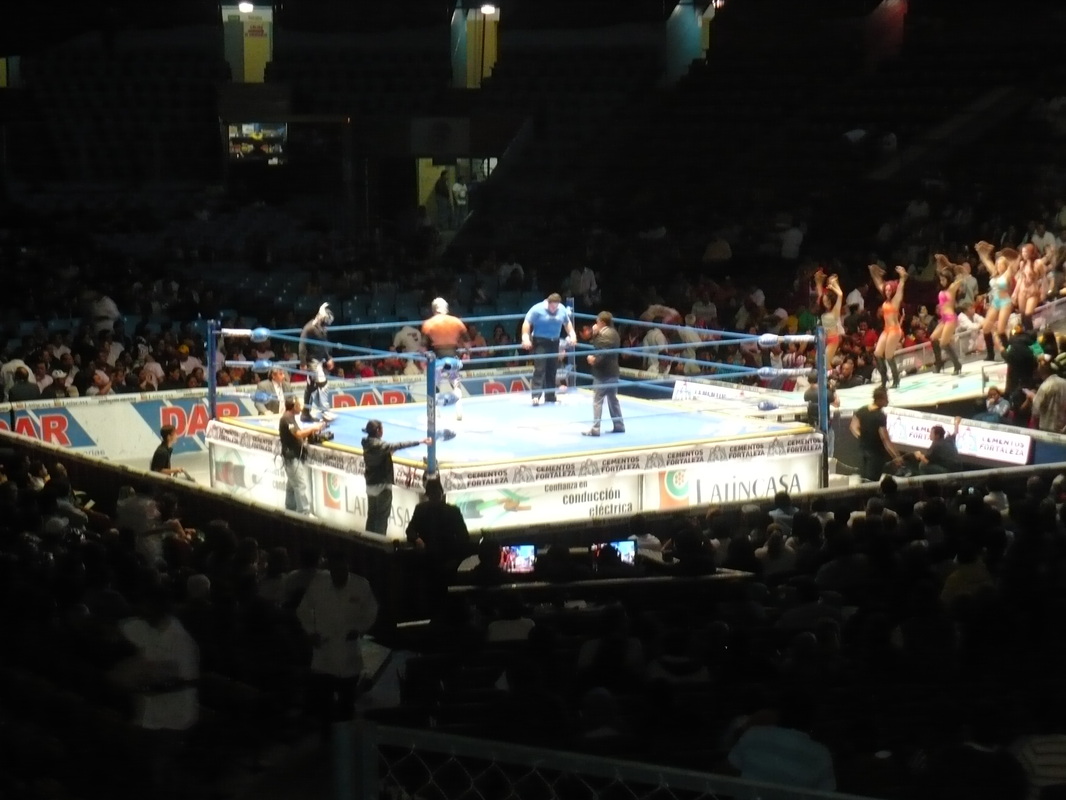










 RSS Feed
RSS Feed